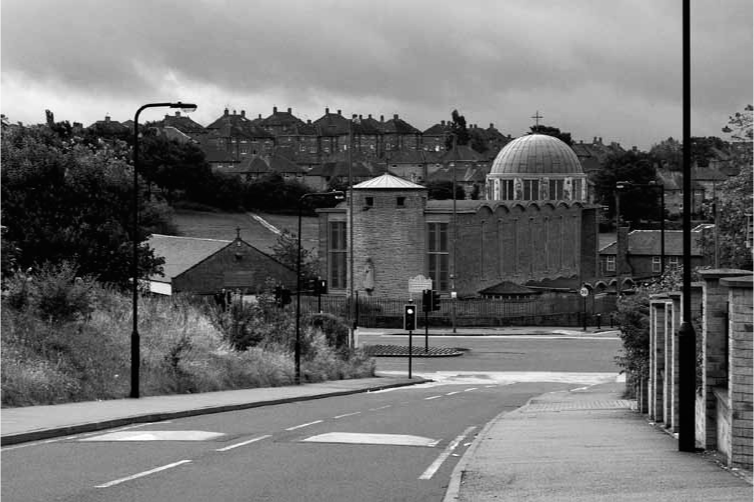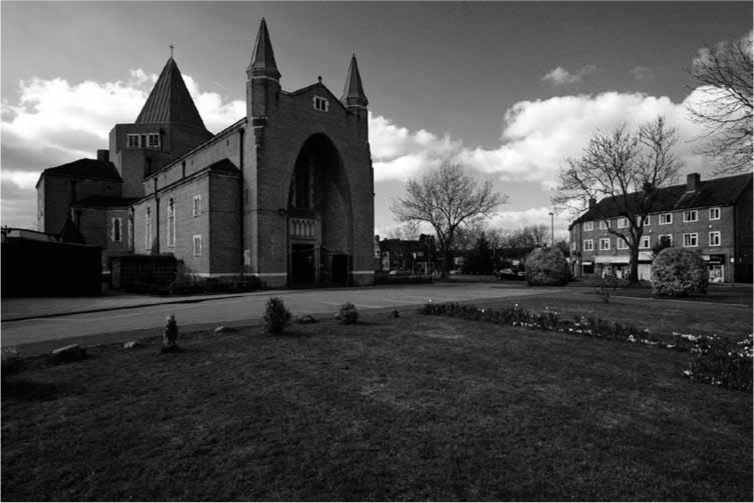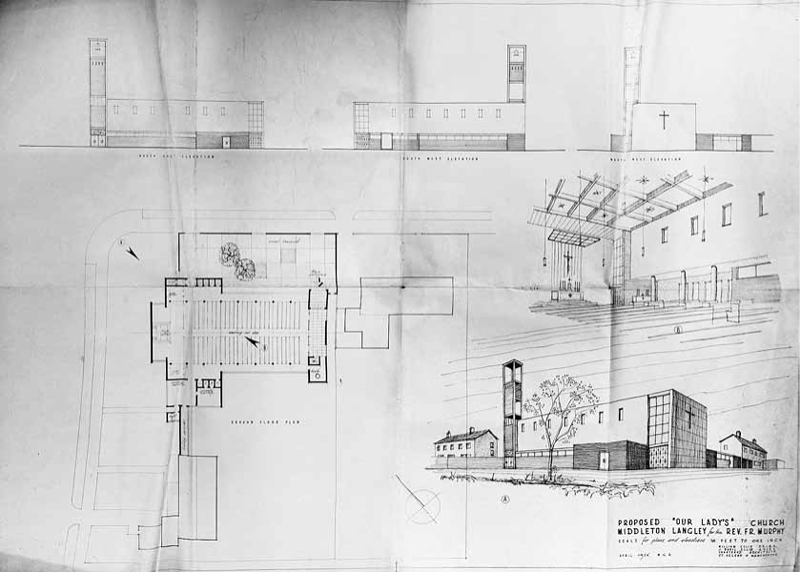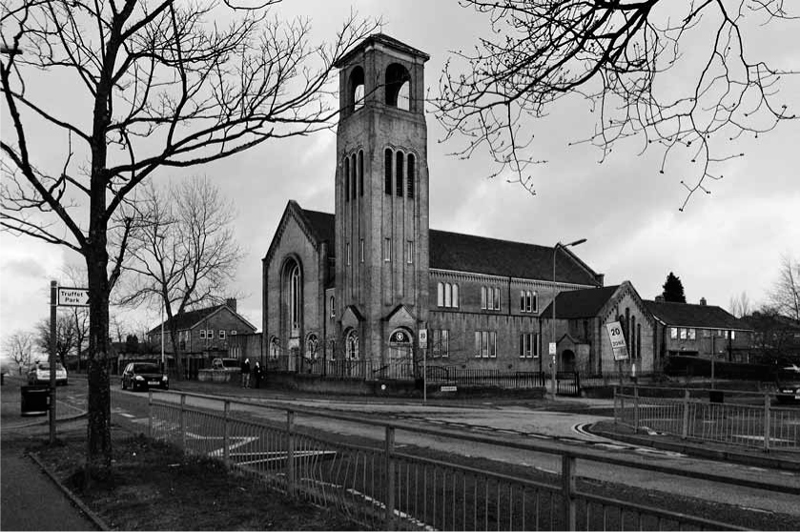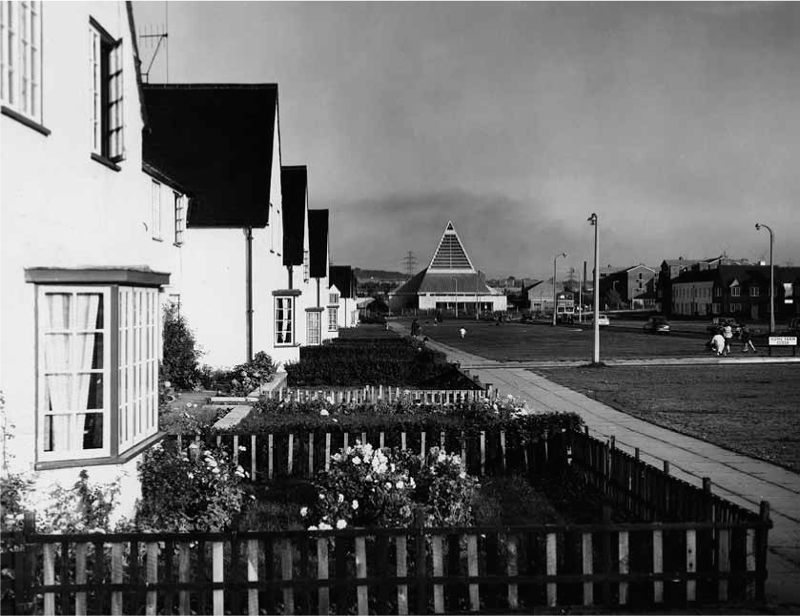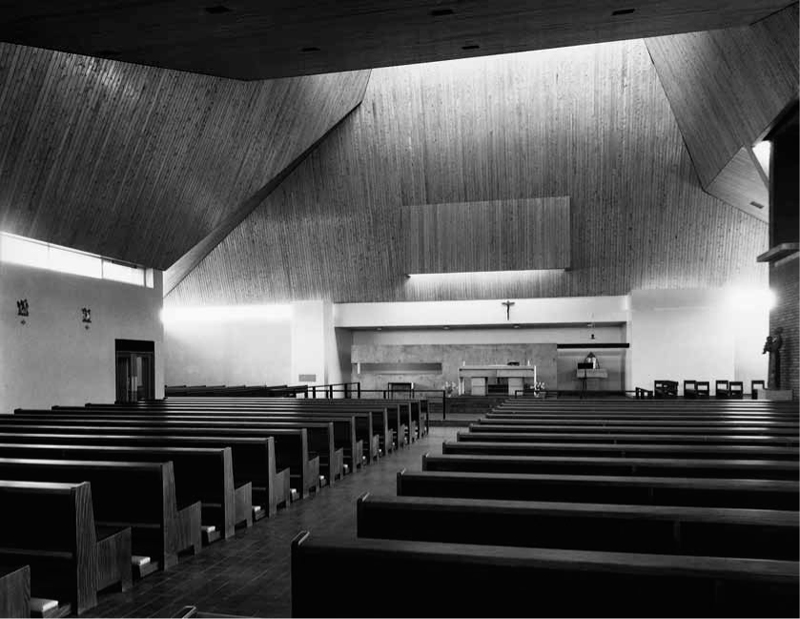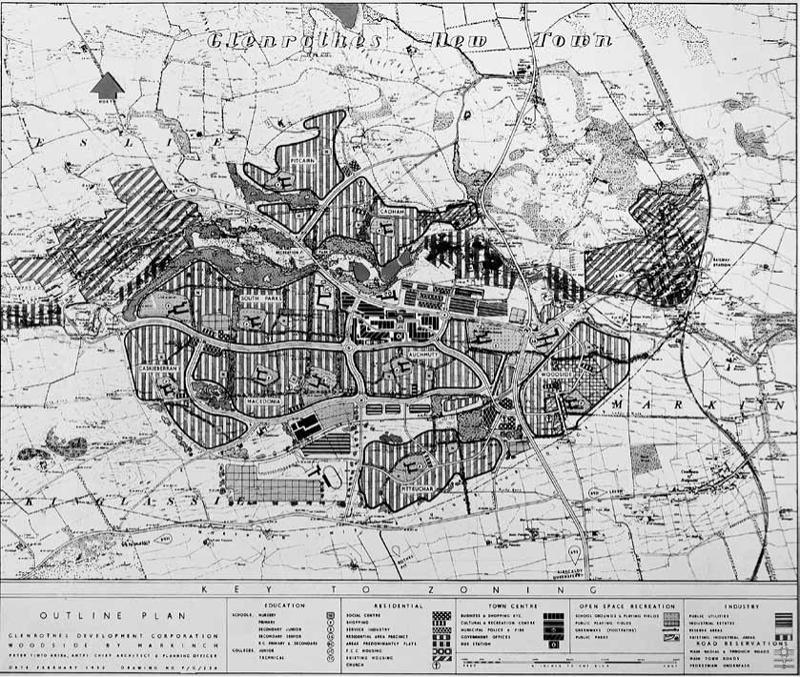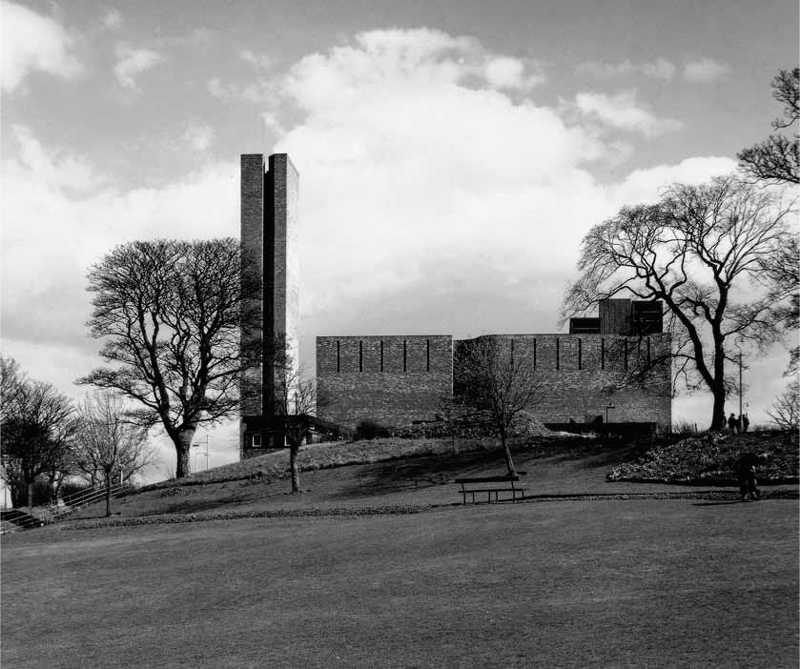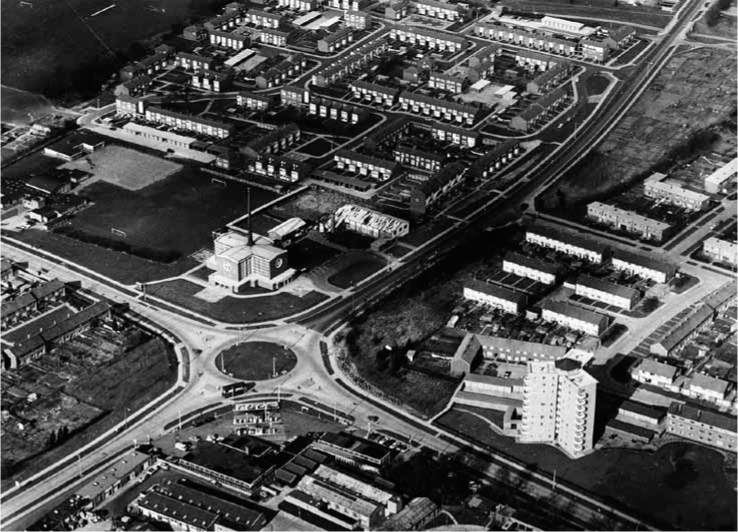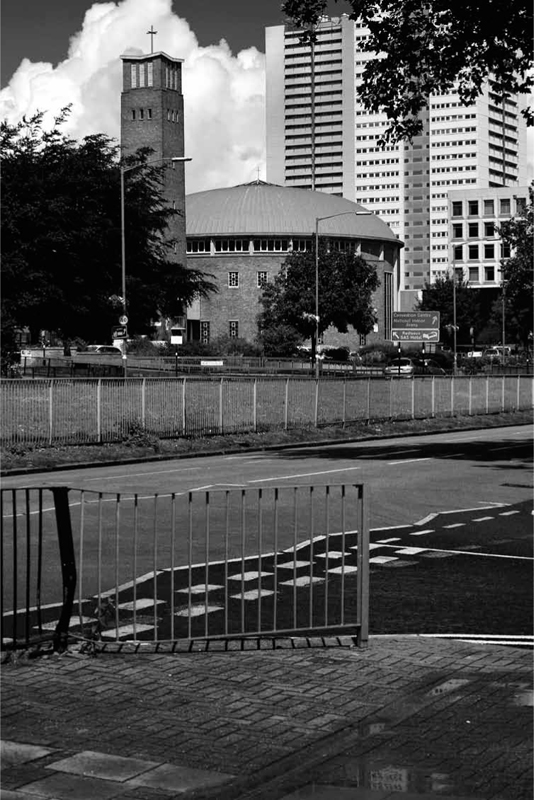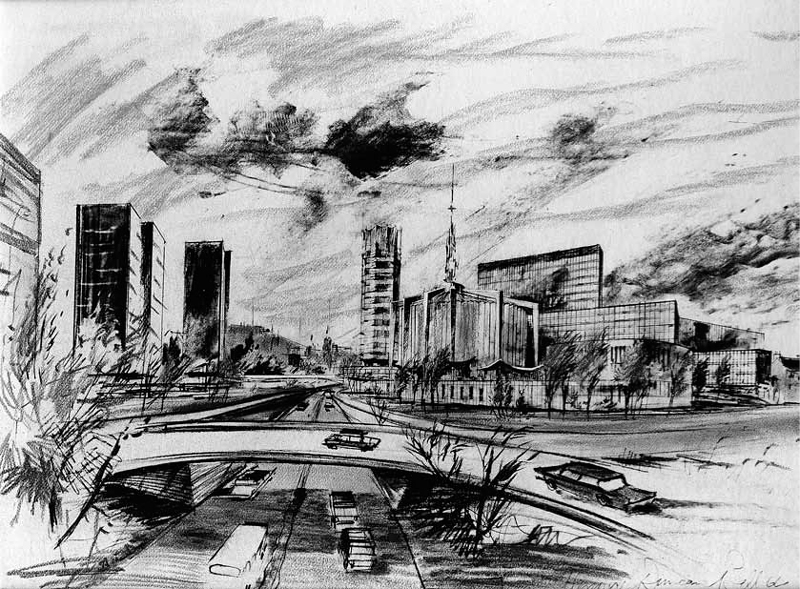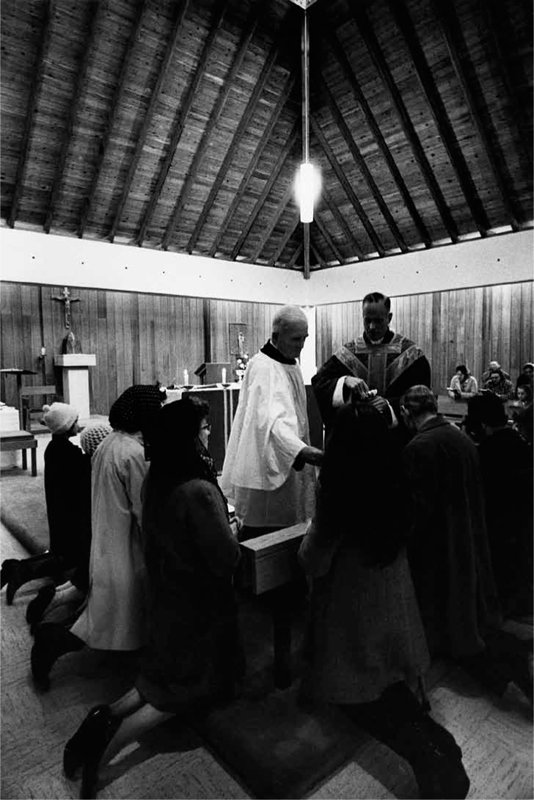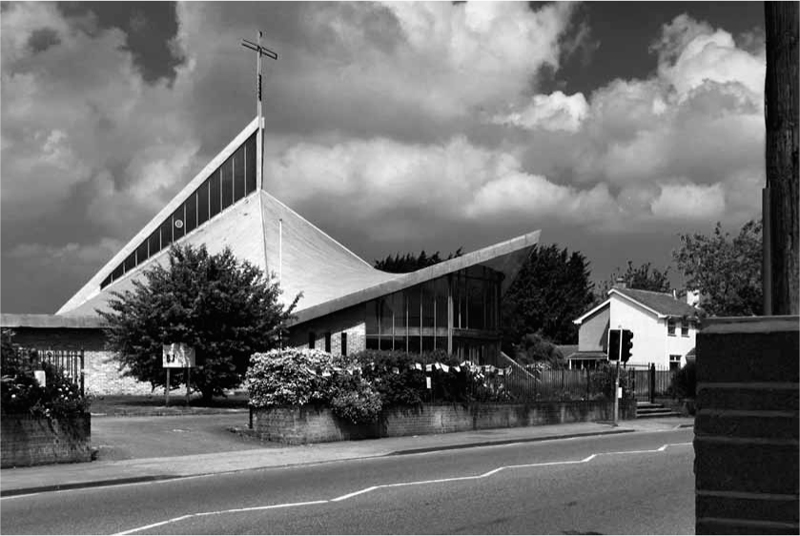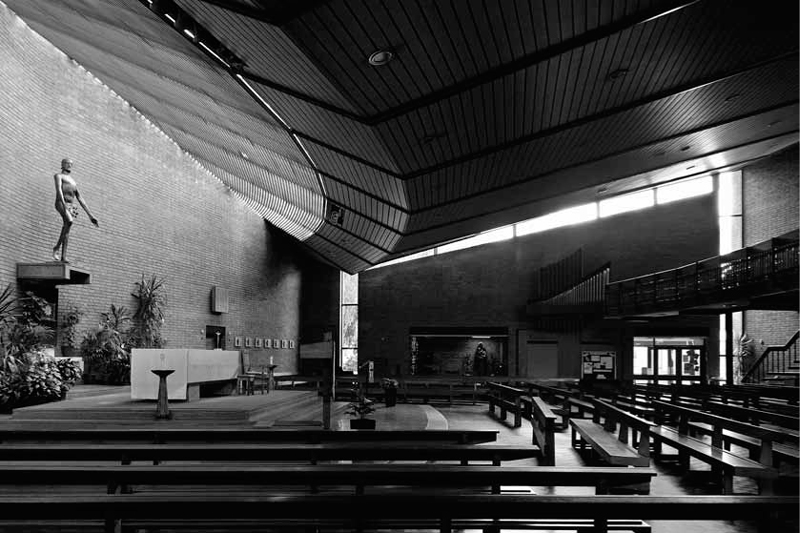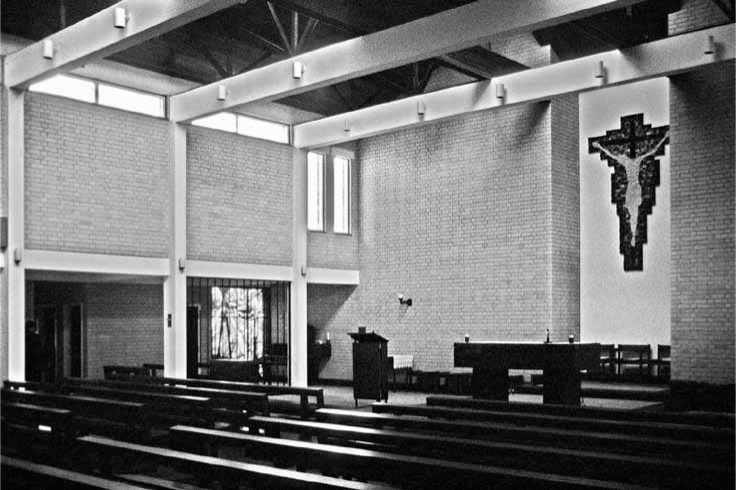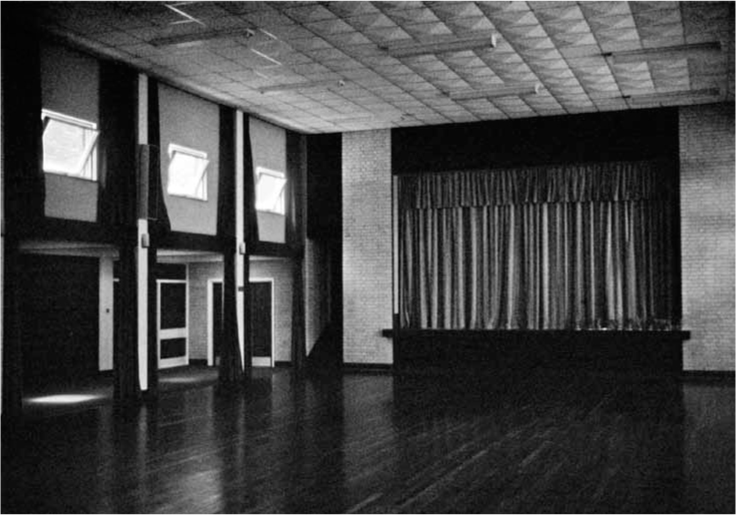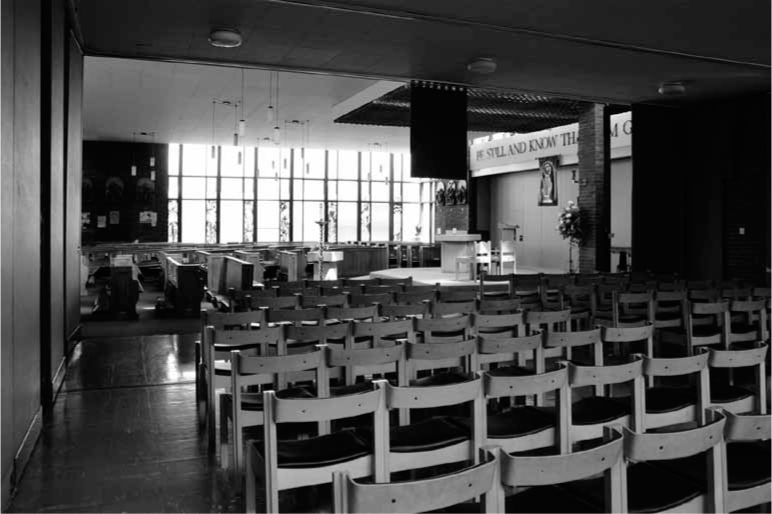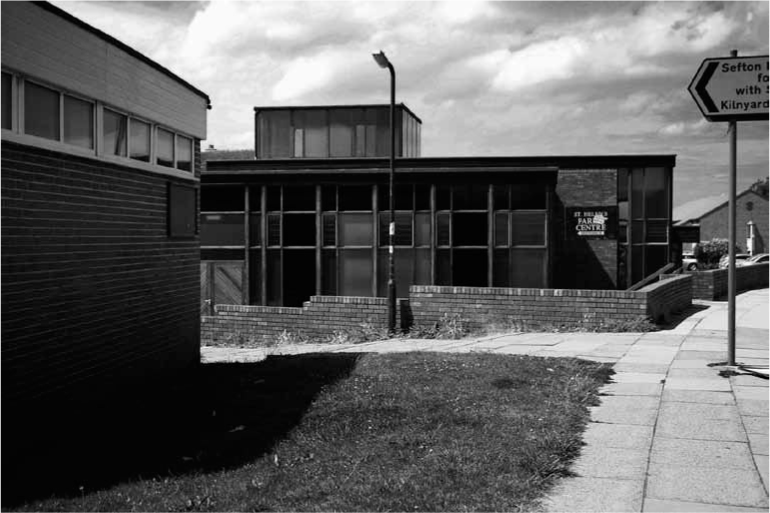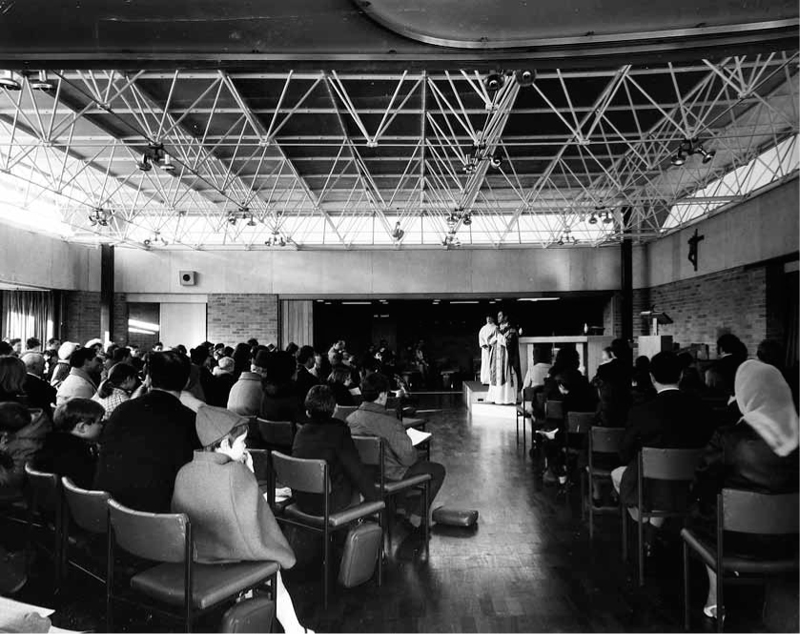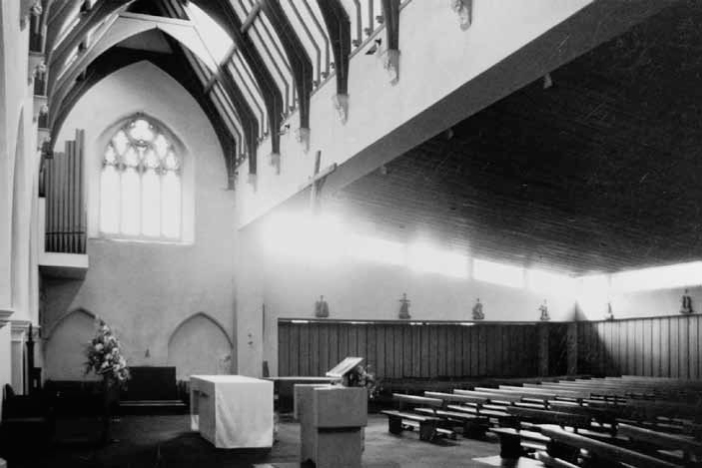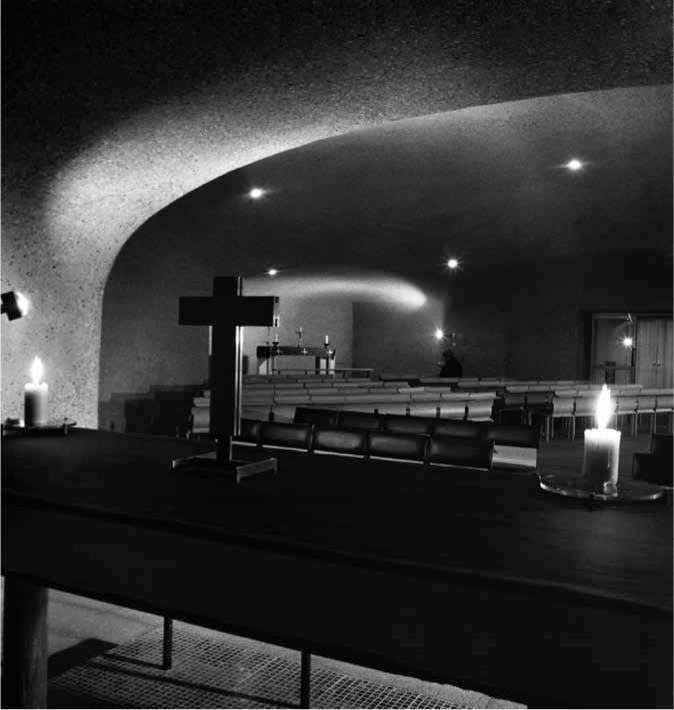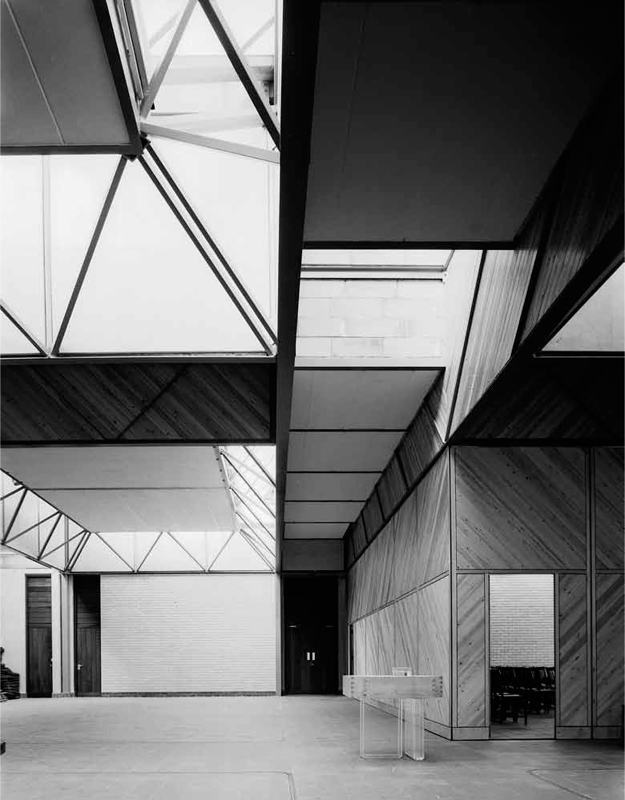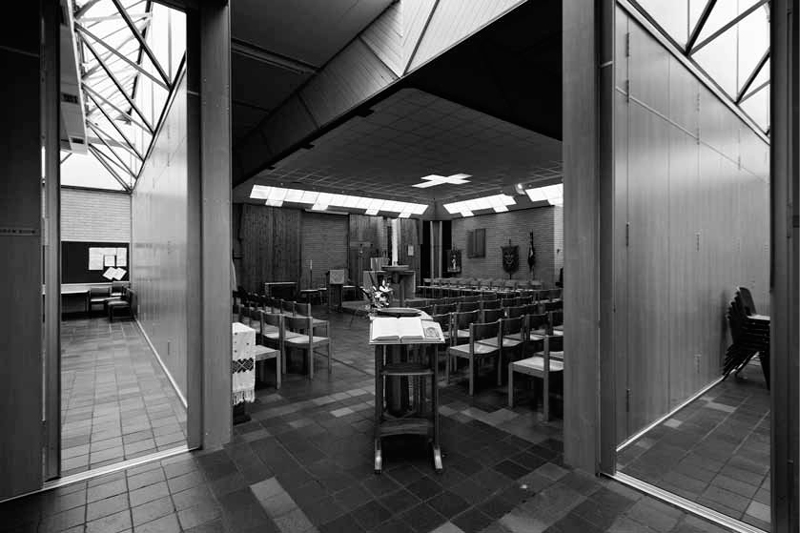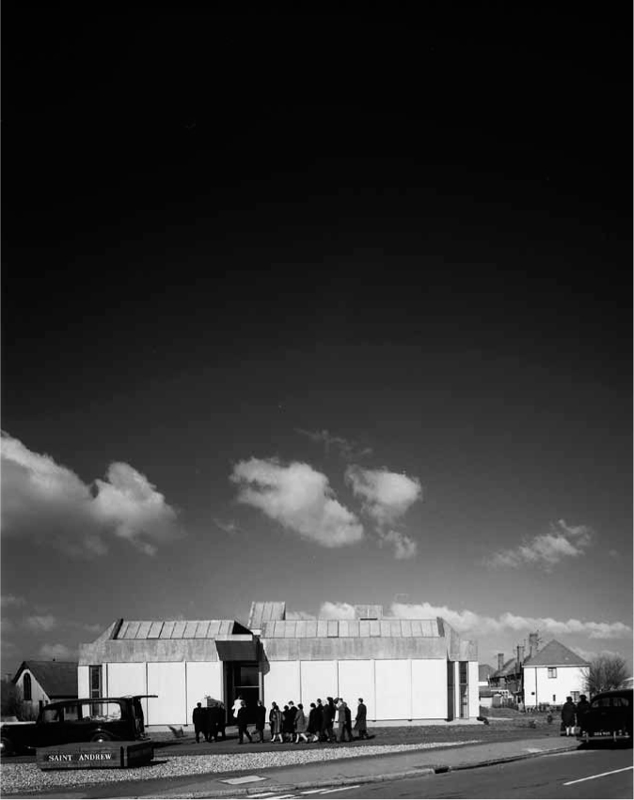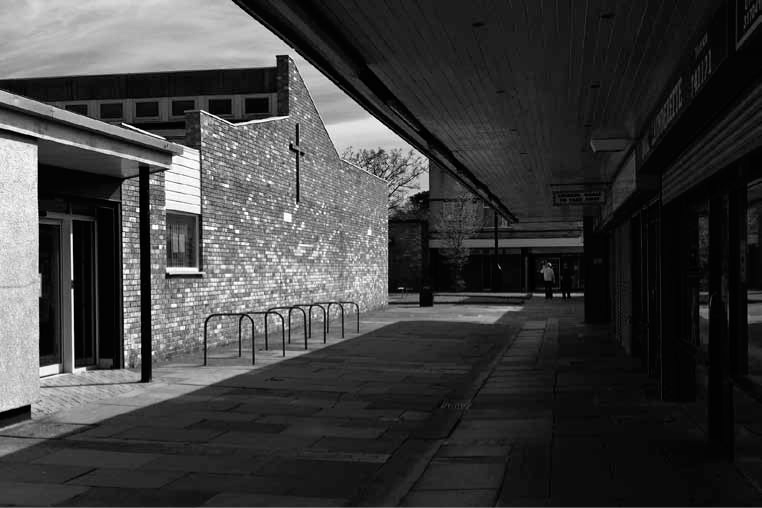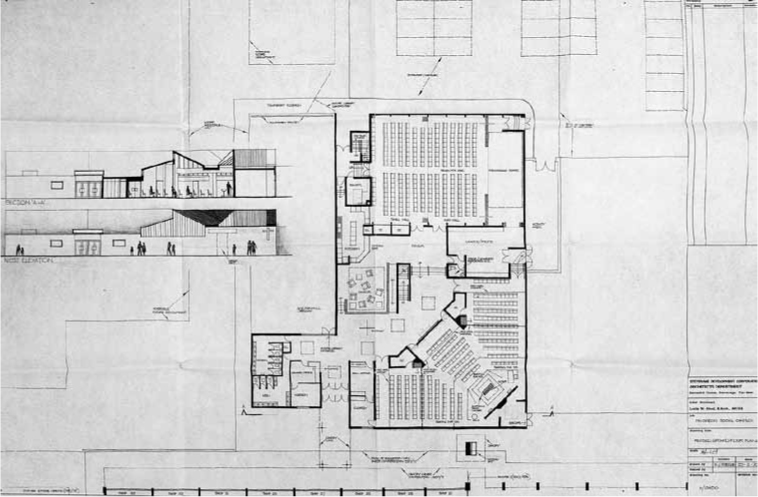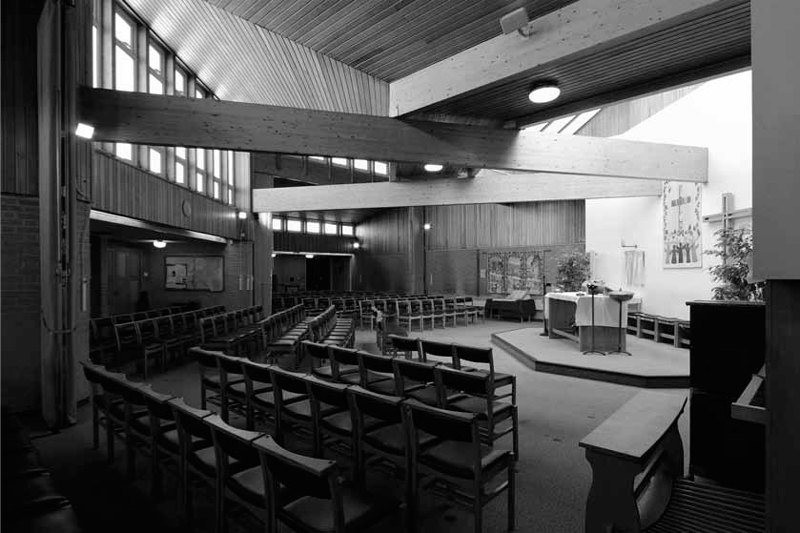10
The Church and the World
The Roman Catholic Church in Britain wanted to claim a civic status, and its architecture contributed to this aim: its embrace of modernism demonstrated its willingness to participate in the modern nation. Yet new theological ideas began to change the Church’s conception of its purpose and its relationship to the world, and church architecture changed accordingly. The siting of churches had theological significance: the relationship between the church building and its environment reflected ideas about the nature of the Church, ideas that changed during these decades. The extent of agreement between clergy and town planners over church siting and design is often remarkable: if the Church aspired to a civic status, it accepted the ways in which that status was framed. But influences went both ways: planners accepted the Church’s changing views and allowed them expression in their cities.
In the 1950s, the parish church was considered a sacred edifice declaring its noble purpose as a shrine of worship and prayer and was often charged with expressing the fervour of the faithful. In the 1960s, this approach began to be attributed to a ‘fortress’ Church, intent on creating exclusionary bastions of faith to keep the faithful under surveillance, within its moral and social precincts.1 These criticisms emerged from the new theology of the Church in the world pronounced at the Second Vatican Council. As early as 1952, Jesuit theologian Hans Urs von Balthasar urged the ‘razing of the bastions’ and the ‘descent of the Church into contact with the world’ in a critique of conventional views that influenced the council’s thinking.2 Theologians who invoked the image of the ‘fortress’ instead supported new models of a ‘pilgrim’ Church and a Church of ‘service’. Monumental churches began to be viewed with suspicion as the symbol of a Church under the delusion of triumph. It was argued that the Church should work more subtly within the world for its salvation, both through liturgy and through more material and social action. The Church had to be open to the world around it rather than confronting it, a view that also implied new attitudes to Christians of other denominations in a growing movement towards Christian unity, or ‘ecumenism’. These concepts found expression in new forms of church and new relationships between church and city.
10.1 St Anthony of Padua, Preston, by Giles Gilbert Scott, 1958–59. Photo: Robert Proctor, 2013
CHURCH AS SOCIAL MONUMENT
Whether traditional or modern in style, churches were often considered as monuments – distinguished urban landmarks, symbols of God’s transcendent presence and eternity and an expression of the strength of the Catholic community. The figure of the fortress was sometimes used positively to suggest the permanence of the Church through its architecture: St Anthony of Padua at Preston by Giles Gilbert Scott, sited on a major road into the city, was described by the bishop of Lancaster as ‘fitted to take its place among the other churches which stood like bastions around the Catholic town of Preston’ (Figure 10.1).3 Yet the design of the parish church was seen as a statement of the presence of the Catholic community within the wider civic body, a contribution to civic space rather than a rejection of it. Monumental churches suggest a desire to Catholicise and sacralise the city, consecrating modern civic endeavour. Town planners strengthened this attitude, encouraging the Church to design prominent landmark buildings.
Churches in new estates and older suburbs were carefully considered to maximise their prominence and visibility. In some cases, sites had been acquired in suburban developments before the war and new post-war churches replaced temporary buildings – at St Theresa, Sheffield, for example, where John Rochford’s modern Byzantine church was sited in a valley, overlooked by housing estates on the surrounding hills (Figure 10.2). New sites were acquired on major roads, central to the housing groups the parish served and often facing busy road junctions or roundabouts. Basilican churches presented their entrance gables to the most important street. Towers were built to make churches visible from a distance, often with illuminated crosses – at Reynolds and Scott’s church of St Bernard at Burnage in Manchester, for example, incongruous neon lighting meant its gable cross ‘can be seen for some considerable distance’.4 At Wythenshawe in Manchester in the late 1950s, the diocese of Shrewsbury obtained a central site in a post-war extension of this large suburban estate, and commissioned Adrian Gilbert Scott for a substantial statement church dedicated to St Anthony. The bishop, John Murphy, insisted that Scott plan the building ‘to dominate the approach from Rudpark Road’ and suggested placing the tower on its axis.5 The building presented its flanking silhouette to this approach so that its west front faced the neighbourhood centre and another junction on the Portway, a major road through the estate (Figure 10.3). Architects and clergy hoped their churches would dominate the urban landscape, representing the Church’s centrality in the lives of citizens.
10.2 St Theresa, Sheffield, by John Rochford, 1959–60. External sculpture by Philip Lindsey Clark. Photo: Robert Proctor, 2009
10.3 St Anthony, Wythenshawe, by Adrian Gilbert Scott, 1957–60. The Portway runs alongside the church; its junction with Rudpark Road is at the centre of the photograph. Photo: Robert Proctor, 2013
10.4 Our Lady of the Assumption, Langley, near Manchester, by W. & J. B. Ellis, 1956–61. Initial design proposal of 1956. Courtesy of Ellis Williams Architects. Source: parish archive
These conventional patterns of siting were maintained in post-war suburban estates, where the urban poor were decanted to garden-city-style housing. Our Lady of the Assumption in Langley, north of Manchester, was typical. Langley was a post-war estate created with new powers granted to city authorities for ‘town expansion’.6 Through its centre ran Wood Street, along which several institutional buildings were planned, including an Anglican parish church, a substantial Catholic school and a neighbourhood shopping centre, while a municipal library and other facilities terminated the road. The provision of such amenities was intended to prevent the estate from becoming a dormitory suburb, helping a permanent community to develop: as Harold Macmillan, Minister of Housing and Local Government, put it, new residents ‘are expected to settle and make a new life, with their industries and employment, their social activities, their churches, their chapels and clubs in the areas to which they are asked to move’.7 Local authorities planning such estates therefore looked favourably on the clergy’s desire to build for their new parishes, allowing churches to become important features.
10.5 Our Lady of the Assumption, Langley, near Manchester, by W. & J. B. Ellis, 1956–61. In the final design the church’s orientation was rotated by 90°, and its tower moved to the road junction; also visible here are a convent on the left and the presbytery on the right. Photo: Robert Proctor, 2013
At Langley the Catholic parish acquired a site at a junction on Wood Street at the centre of the estate and at its highest point. W. & J. B. Ellis were selected as architects, and their initial design of 1956 showed a modern church presenting its flank to Wood Street (Figure 10.4). The diocese of Salford insisted on a revision to enhance the church’s presence by turning the gable to this main road, and a revised design followed accordingly; eventually, the new orientation was kept but the style changed to Romanesque (Figure 10.5).8 The architects proudly explained that their church would ‘dominate the new estate’, where it was to ‘stand on the crest of the hill on the main approach road from the old town centre … and will be clearly visible from all parts of the estate’, an aim enhanced by its lofty campanile.9
Of the 22,000 new residents of Langley in around 1960 a third were Catholic. Within 10 years, parish priest John Murphy, with help from Bishop Beck of Salford, arranged for five new schools and two convents of nuns providing household assistance to parents and the aged, besides the church itself costing £100,000 and seating 800.10 New estates such as Langley had unusually high proportions of young families, who took priority in city re-housing programmes. Church attendance was comparatively high, perhaps partly because Catholic schools required attendance for admission, but also because new residents sought social contacts before other neighbourhood networks had become established. Church buildings therefore seemed urgent for pragmatic as well as symbolic reasons. As in many other places, the parish church was one aspect of a campaign of provision for Catholic settlers – migrants, in a way, however short the distance – helping them adapt to their new situation. The Byzantine-Romanesque style of Ellis’s church with its vivid internal mosaics, especially typical of Lancashire, made a reassuring impression for Catholics uprooted from the city and resettled in unfamiliar surroundings, converting the space of modern planning into a place of significance and identity.11
While Langley benefited from a range of municipal facilities, other places were less fortunate, and churches provided a civic life where the city had failed. At the pre-war estate of Southmead in Bristol, the central open space of a new housing estate became a religious centre: four churches were constructed around a green immediately behind the shopping area. Bristol’s pre-war housing had been sharply criticised by local sociologist Rosamond Jevons, who reported that suburban estates lacked adequate facilities and attributed widespread anti-social behaviour to ‘the absence of a social cement’.12 A decade later, Southmead still lacked any municipal facilities, but the principal Christian denominations had established themselves in temporary buildings around the estate, and their provision of halls and rooms and their organisation of social life compensated for this complete absence of provision by the city.13
One of Jevons’s criticisms of Bristol’s housing was that the central areas were fragmented, and their greens had no purpose: ‘some centres have sacrificed the sense of unity through their excessive area of unusable open space’, she wrote, ‘and by the scattering of public buildings too uniformly around their fringes. The scale is too large for the size of buildings.’14 If the corporation (as the city council was called) could rarely provide substantial public buildings, it evidently realised that the churches would do so and accorded them prominent sites. The Catholic church of St Vincent de Paul designed by Kenneth Nealon was the first permanent church at Southmead, its site on the highest corner of the green obtained from the corporation, and the other denominations followed, one on each corner. Churches provided estates with the image of a township and of a coherent community that was otherwise lacking: as the Anglican priest of St Stephen phrased it, the churches could ‘build up our “Southmead consciousness”’.15
In another estate, churches were, unusually, planned from the outset. Richard O’Mahony’s church of St Michael and All Angels at Woodchurch outside Birkenhead benefited from its extraordinary siting and responded to it meaningfully. Woodchurch was planned as a ‘garden city’ housing 10,000 and including two new churches, and Herbert Rowse of Liverpool was appointed architect-planner in 1947.16 Rowse’s scheme was Beaux-Arts in plan, three broad green boulevards radiating down the hill from the existing medieval Anglican church. Community facilities lined the central avenue and the two new churches were sited on a secondary boulevard.17 In contrast to pre-war estates, Woodchurch was designed with a social infrastructure: ‘The Woodchurch Estate’, wrote Rowse, ‘is … the architectural setting of a fully developed sociological conception of a community of people living within a defined neighbourhood, having a conscious identity of its own and equipped for the maximum possibilities of the full social intercourse of such a community’.18 Rowse’s arguments reflected developments in modernist urbanism, the need for a ‘heart of the city’ being an important aspect of the thinking of CIAM after the war. The realisation of residents’ needs for social life prompted the integration into the urban plan of institutional buildings, which included churches.
10.6 St Michael and All Angels, Woodchurch, Birkenhead, by F. X. Velarde Partnership, 1962–65. Photographer unknown, c.1965. Source: Architectural Press Archive / RIBA Library Photographs Collection
By 1960, the Roman Catholic parish of St Michael and All Angels was given a broad site at the end of this boulevard of housing, facing along its axis to the Anglican church a mile away at the top of the hill (Plan 7b). O’Mahony inherited the church commission from Velarde, who had already built the presbytery and planned a church off-centre. O’Mahony instead placed the church as close as possible to the axis so that the church terminated the street. Since the medieval church formed the focal point of the estate and the Catholic church took a marginal and opposite position, this urban setting presented an image of the structure of the nation, overseen by the established Church, within which Catholics hoped to take an important part. Lance Wright commented on the Catholic church’s siting with wry bemusement, noting that, despite the emerging ecumenical movement, the planners had imposed ‘a formidable display of disunity’ amongst the faithful: on Sunday mornings Anglicans walked up the hill to church and Catholics walked past them on the way down.19
10.7 St Michael and All Angels, Woodchurch, Birkenhead, by F. X. Velarde Partnership, 1962–65. Sculpture of the Virgin and Child by Norman Dilworth. By permission of Norman Dilworth. Photographer unknown, c.1965. Source: Architectural Press Archive / RIBA Library Photographs Collection
While the estate was Beaux-Arts in plan, its housing had an Arts and Crafts appearance with pitched-roofed cottage-style terraces. The housing was meant to give the estate ‘the general character of a contemporary version of the traditional English village scene’, invoked also by the huddling of housing around the medieval church and the linear versions of village greens onto which the avenues’ houses faced.20 O’Mahony’s church design reflected the domestic roofs of its neighbours, with a modern twist: their angles were continued in its hipped construction; their gables found a resonance in the lantern that completed the church’s aluminium-covered pyramid; and a chimney was implied with a blue-brick pillar that housed the sculpture of the Virgin (Figure 10.6). The church was conspicuous, an unmistakeably religious building type within its housing context, suggesting a conventional understanding of the transcendence of the Church in the world. Yet it was also modest, raising the domestic to a higher plane.21 The shape of the roof was carried through to the interior, its pine-boarded underside a symbol of shelter unifying the family of worshippers (Figure 10.7). In echoing and transforming the architecture of the house, it suggested the origins of the church in the early Christian house-church commonly evoked by the liturgical movement. O’Mahony’s church at Woodchurch marked a beginning of transition in Roman Catholic church design away from a monumental approach.
PERMANENCE AND MODERNISM: NEW TOWN CHURCHES
In the post-war New Towns monumental churches were actively encouraged by planners. Modern architecture was also preferred, and was accepted by clergy as appropriate to the setting: a monumental modernism therefore followed. New Towns had a larger scale and sense of political importance than suburban estates, and planners, architects and clergy all hoped that churches could contribute to the creation of a civic identity and community.
Glenrothes illustrates how clergy and planners negotiated the incorporation of churches into the New Towns. As in most other New Towns, its first master plans of 1949 by architect-planner Peter Tinto contained no church sites at all. When the Church of Scotland requested a site, it was told to collaborate with other denominations through an ‘Inter-Churches Committee’.22 These committees existed throughout Britain after the war: originally tasked with co-ordinating joint applications for building licences, they soon found another purpose in apportioning sites in new developments, and when licensing ended in 1954 this became their primary function. At Glenrothes the inter-churches committee presented the development corporation with a demand for 12 church sites in total, one of which was for Catholics.23 The 1952 outline plan was then marked up with sites for churches (Figure 10.8). Most proposed locations were at prominent points on main roads, several at roundabouts; some were in the town centre, others in neighbourhood units, a few at the edges of the town as potential landmarks on approach. The Catholic parish was initially offered a prominent site at a corner of the town centre facing a traffic intersection.24 The diocese was advised to accept it quickly, as it would be in high demand: ‘You have been able to get in on a first rate site in the very heart of the Town’, wrote their solicitor.25 Later, however, the archbishop requested a different location, further east and conspicuous within a neighbourhood, placing the Catholic church more centrally in relation to its parishioners, as Glenrothes developed first towards the east.26 These negotiations between the development corporation and the denominations show a pragmatic rather than principled approach to planning churches, but planners and churches all agreed in wanting landmark sites for both social and visual reasons.
When the archdiocese acquired the site, it came with a condition normally applied by New Town development corporations to private buildings, that a permanent building had to be completed within a fixed time limit. In most cases of New Town churches, this condition made it impossible to build up a site and a parish in stages in the normal way. Glenrothes refused the Catholic diocese’s request to build a temporary church, while Archbishop Gray thought that to build a permanent church immediately ‘would put an intolerable burden upon the small congregation’.27 The diocese’s request for the alternative neighbourhood site undoubtedly reduced the corporation’s expectation of a substantial building, and allowed Gillespie, Kidd & Coia’s modest church of St Paul to be completed within the required timeframe. Planners exerted pressure on churches to build quickly and ambitiously, hoping to show rapid progress in building the New Towns, avoiding the criticisms that had been made of suburban estates.
10.8 Glenrothes New Town Outline Plan, by the Glenrothes New Town Development Corporation Architects’ Office under Peter Tinto, 1952, showing sites for churches. By permission of Fife Council Archive Centre, Glenrothes
Gillespie, Kidd & Coia were probably chosen as architects at Glenrothes because of the New Town location. Reginald Fairlie had originally been commissioned for sketch designs for the central site, but was soon dismissed. The archdiocese briefly considered holding a competition for a new church design, to be judged by the development corporation. They appointed Coia, however, perhaps because he was already involved with St Bride’s at East Kilbride.28 Metzstein and MacMillan explained how they had considered their design for Glenrothes in relation to its context: ‘The design of the buildings is intended not only to embody the relatively modest accommodation in striking form, but also to express the adventurous spirit of the New Town’, they wrote: the tower, lighting the altar below, would serve as a ‘landmark’.29 When the architects exhibited a model in the town, parish priest Pierce Grace wrote excitedly to Coia that ‘the impression made was extremely good. One heard such expressions as: exciting, fascinating, unique etc. The Corporation officials were unreserved in their commendation. Taylor the County Planning Officer expressed his “great pleasure” that it was on show’.30 The clergy were anxious that the church should be seen as a building worthy of its modern context. Their sensitivity to non-Catholic opinion suggests that they wanted their church to represent the New Town’s Catholic community to others, showing that it was an active and contributing part of the new society that the New Town enterprise sought to create.
10.9 St Bride, East Kilbride, by Gillespie, Kidd & Coia, 1957–64. Photo: G. Forrest Wilson, c.1964. Source: Glasgow School of Art
In richer and more optimistic dioceses and more confident New Towns, such pressure from planners for early permanent churches was more eagerly accepted by the clergy. At both East Kilbride and Harlow, the Catholic Church undertook substantial modern buildings in harmony with New Town design principles as contributions to their civic environment. At East Kilbride, parish priest John Battel urged the diocese of Motherwell to build a ‘commodious and attractive building, something of the dignity and character of a Catholic Town Centre, standing at a focal point’.31 As early as 1952, Battel agreed a central site for the future permanent church, and a site for a second parish church in the Westwood neighbourhood.32 The central site offered by the development corporation was prominently located on top of a hill that was to be left as a park, next to a Catholic school already being built, overlooking the main road from Glasgow (Plan 7a). Francis Scott, architect-planner for East Kilbride, praised the site’s ‘dominating character’ and copious open spaces, and Coia advised the diocese that it was ‘admirably placed for a church’.33 Metzstein and MacMillan’s design linked church and presbytery across a courtyard to enhance the scale of the building, and the church’s sheer brick bulk and modern tower dominated the approach road from the hilltop (Figure 10.9). At its opening in 1964, it was revealed that from the beginning the bishop of Motherwell, James Scanlan, by then Archbishop of Glasgow, ‘had set his heart on “the provision of a church of the architectural distinction appropriate to this great venture in town-planning”’.34
10.10 Anglican church of St Paul, Harlow New Town, by Humphrys & Hurst, 1957–59. Photo: Robert Proctor, 2010
The site for the second Catholic church at East Kilbride, Our Lady of Lourdes, was also provided by the development corporation and was similarly positioned on an embankment overlooking another main road. This time the development corporation offered to build the church themselves, its chairman, Sir Patrick Dollan, a Catholic and former Provost of Glasgow, noting that ‘the site is an excellent one and worthy of the best buildings we can design and construct’.35 The church was designed by Robert Reid of the development corporation architects’ office and opened in the same year as St Bride.36 Not only was the form of its site similar to that of St Bride, but so was its design, a modern brick and reinforced-concrete rectangular building, its gable and detached tower overlooking the road, though its detailing owed more to Coventry Cathedral than to Metzstein and MacMillan’s brutalism. At East Kilbride, planners, clergy and architects collaborated in producing a modern monumental form of church.
The urban situation of Our Lady of Fatima at Harlow New Town was no less important than its liturgical innovations. At Harlow, architect-planner Frederick Gibberd had already proposed a church as a feature of the town’s civic centre, and the site was granted to the Church of England for their church of St Paul, a modern building designed by Derrick Humphrys (Figure 10.10). Through the Essex Churches Reconstruction Committee, the equivalent of the inter-churches committee at Glenrothes, the Catholic diocese of Brentwood requested three church sites.37 Bishop Beck wanted their churches to be close to the Catholic schools, whose siting had been agreed in the early stages of the master plan.38 The first church site was therefore agreed alongside a school on a main road, close to a roundabout between the town centre and Mark Hall North, one of the earliest neighbourhoods. Clergy and planners both gave careful thought to the treatment of this site.
Initially the Catholic site, which was also to contain a convent and church hall, did not extend to the road junction, but consisted only of a strip along First Avenue. At a meeting between Beck, parish priest Francis Burgess, their architect R. A. Boxall and the development corporation, it was agreed that ‘both the Roman Catholics and the Corporation were anxious to secure first-class usage and architectural relationship between the buildings and an impressive frontage to First Avenue’.39 Clergy and planners agreed to extend the site around the corner onto Howard Way. Eric Adams, General Manager of Harlow Development Corporation, thought ‘that by rounding the corner the appearance of their scheme as a whole might benefit from a sense of greater compactness and more effective use of the corner’.40 The planners expected the Catholic church to provide a monumental landmark facing onto the roundabout, and the clergy and their architects agreed, proposing to place the church in this position and promising completion within five years (Figures 10.11, 10.12).
In contrast to the parish of Our Lady of Fatima, a priest in the south of the town who wanted to build a modest temporary church a few years later was snubbed: ‘From a planning point of view we would not wish to see a building of this character in the New Town’, the planners complained, noting that their policy was ‘to encourage ecclesiastical bodies to put up permanent buildings from the outset’, even though all denominations found this difficult.41 Eventually a permanent church of the Holy Cross was opened in the south of the town, and a further church, St Thomas More, was built by Burles, Newton & Partners in a prominent location in the Little Parndon neighbourhood a few years later. New Town planners prevented the construction of temporary buildings for aesthetic reasons, demanding ambitious permanent churches in return for their allocation of prominent sites.
The selection of Gerard Goalen as architect for Our Lady of Fatima was also related to the New Town context. Goalen was a senior architect for the Harlow New Town Development Corporation under Gibberd designing factories for the town’s industrial estate. His final-year thesis project at the University of Liverpool had been a modern pilgrimage church, inspired by Auguste Perret’s church at Le Raincy, a design he showed to Burgess.42 Goalen was also recommended to Burgess by Gibberd:
He would design a building which would look well and would fit into the overall scheme. I have been a bit worried about the general treatment of your site, in that there is a danger that as different architects have been working on it, it will not hold together as a total design. … Here again Mr. Goalen might be very valuable to you.43
10.11 Our Lady of Fatima, Harlow New Town, by Gerard Goalen, 1954–60. Photo: Ray Stebbings, c.1960. Source: reproduced by courtesy of Essex Record Office, Chelmsford
10.12 Our Lady of Fatima, Harlow New Town, by Gerard Goalen, 1954–60. Photo: Robert Proctor, 2010
Others in the development corporation concurred, and their approbation was an important factor in the parish’s choice of architect: the likelihood that he would build a church in keeping with Harlow’s design ethos appealed to planners and clergy alike.44
Goalen’s church was similar to the T-shaped concrete-framed Anglican church of St Paul, though his tall spire and dalle de verre windows tempered the building’s modernism with historical reminiscences. Goalen wrote in favour of monumental churches: ‘A church is the house of God. It should be as fine a building as we can afford, and … its scale should be generous.’45 The development corporation, the parish priest and even, as the diocese discovered when it questioned the cost, the parishioners, all shared in this opinion.46 The building’s plan, liturgically innovative as it was, followed logically from the church’s urban situation. The T-shaped nave with identical arms and entrance gables was appropriate to the corner site, the church facing each direction from which it would be viewed and approached. The liturgical movement’s egalitarian principle of the gathered congregation was also politically allied to the egalitarian ideals of the New Town. Goalen’s church embraced the spirit of the New Town, providing the Catholic community with a space that connected their modern social and physical environment with their religious lives.
Some of these buildings might well seem to justify the notion of the inward-looking fortress Church, monumentality and permanence implying isolation from the transitory secular world. St Bride at East Kilbride, lacking any windows and entered from a courtyard, detached from the world around it, could be seen to fit this image. Yet these and many other churches also suggest otherwise. Their prominent siting shows a desire to contribute to each town’s identity, participating in the post-war programme of resettlement and the establishment of new communities. Planners, meanwhile, wanted landmark churches to present their towns as balanced and settled places. Catholics adopted modern architecture to show their participation in the modern venture of the New Town: as their worshippers came to reside in modern houses, to shop in modern shopping centres graced with modern art, to work in newly built factories and study in bright modern schools, so they were to worship in churches that expressed the universal faith in the character of the modern town.
CHURCH AS MODERN URBAN LANDMARK: CITY CENTRES
Inner-city areas were also radically transformed by planners, often demanding urgent consideration from the clergy. Here, too, the Church accepted and engaged with the emerging modern city in the architecture of its churches. A comparison between church projects in Birmingham and Edinburgh, however, shows how this ambition began to be questioned. Like many other British cities, Birmingham’s centre was broadly redesigned after the war in response to modern ideas in urbanism, including the zoning of urban functions, high-rise housing and new forms of traffic management. Birmingham’s City Engineer, Herbert Manzoni, and, from 1952, City Architect Alwyn Sheppard Fidler, undertook major new road schemes and a massive programme of slum clearances and tower blocks. One of these projects was a ring-road encircling the city centre, originally mooted in the 1930s, planned in 1943, and begun in the late 1950s.47 Its first section went straight through Dunn and Hansom’s substantial late-Victorian Roman Catholic church of St Catherine of Siena at Horsefair. The city set aside a new site for a replacement church in a key position on the outer edge of the ring road, looking across it towards a future shopping centre.
Parish priest Robert Nicholson considered appointing Bower Norris as architect, but a committee of his parishioners changed his mind: ‘it was pointed out that this was a grand opportunity for an enthusiastic and able young architect to make a name for himself’, he told Archbishop Grimshaw. ‘He couldn’t have a greater incentive than an important church on a conspicuous site in the centre of the city.’48 The modernity of the new setting suggested the need for a young modern architect: ‘Since the whole area is going to be completely rebuilt over the next few years and our site will be a very prominent one, it would be unwise to wholly ignore the Contemporary environment’, wrote Nicholson. Moreover Fidler had declared himself ‘very interested in the building we are going to put up’, conveying to Nicholson a sense of responsibility towards the modern city.49 Nicholson then appointed church architects for the diocese Harrison & Cox, who gave the job to a young assistant, Bernard James.50 James’s circular plan may have been inspired by the liturgical movement, but it was also a response to the isolated and prominent site on the ring-road (Figure 10.13). Its simple volumes read well at speed and from a distance; its tower was an instantly comprehensible sign; its circular plan addressed views from around the road junction. St Catherine was substantial in scale and cost partly because of the city’s expropriation grant, but also because Birmingham’s policy of inner-city high-rise housing meant that this remained one of the diocese’s most populous parishes, over 2,500 Catholics attending every Sunday in the mid-1960s.51
A similar scheme was proposed for the Roman Catholic Cathedral of St Mary in Edinburgh, but its abandonment marked a change of approach. The cathedral occupied an early Gothic-revival church by James Gillespie Graham, opened in 1814, originally hemmed in amidst Victorian tenements. In 1963, it found itself at the centre of a newly declared Comprehensive Development Area: Edinburgh Corporation planned to demolish swathes of tenements and build new housing; a developer would build a commercial megastructure on the hill behind the cathedral; and the cathedral would face a junction on a newly planned motorway ring-road.52 The diocese, which also owned a disused theatre on the site, was courted by the city planners, who asked the archbishop if the developers could make proposals affecting, and potentially moving, the cathedral. The archdiocese cagily accepted: ‘We would naturally wish to make our development in keeping with the development of the whole area’, wrote the Vicar General, James Monaghan, who hoped for ‘a Cathedral precinct worthy of the City’.53 The diocese was eager to participate in the new development but was also concerned that a developer would ignore them, a worry the planners assuaged.54
10.13 St Catherine of Siena, Horsefair, Birmingham, by Harrison & Cox, 1961–65. Photo: Robert Proctor, 2009
10.14 Cathedral of St Mary, Edinburgh. Sketch proposal for rebuilding the cathedral by T. Harley Haddow & Partners, 1966. Perspective by Alexander Duncan Bell showing view from Leith Walk. Source: Scottish Catholic Archives, Edinburgh
The following year, however, representatives of the diocese were called to a meeting with the Town Planning Officer, who asked whether the diocese would agree to relocate the cathedral altogether if a new site could be found west of the centre to ‘give the Cathedral prominence’. The meeting concluded with a demand ‘to clear our minds on the image we want the Cathedral to portray in the City’.55 The diocese decided not to move, but considered a new cathedral inevitable: when the large and complex developments surrounding it were complete, they would not only leave the cathedral outdated and irrelevant, but the road layout would obstruct access to its entrance, so it had to be designed to address a new pedestrian route behind the existing site.56 The diocese commissioned sketch designs and a model from engineer Tom Harley Haddow, who proposed a giant circular drum inside a reinforced-concrete frame (Plate 16, Figure 10.14). Its form would give it prominence as a unique building in an anticipated setting of rectilinear blocks and meant that it addressed both the road and the pedestrian approach from the future St James Centre. It was well received by the clergy: ‘If this scheme were to materialise it would certainly give us a Cathedral and precincts worthy both of the Church and of the City’, wrote Archbishop Gray, adding that everyone who had seen it had been ‘most impressed’.57 A combination of anxiety and excitement over the city’s transformation inspired a vision of a new cathedral that engaged with the modern city in its own terms.
The construction of the St James Centre proceeded, but neither the motorway nor the new cathedral were built. Pressure from residents halted the ring-road.58 The St James Centre’s precast concrete bulk created a discordant backdrop to the ageing cathedral, but there were several reasons for the diocese to set aside its proposals of 1966. One was that the archbishop consulted Robert Matthew, then Professor of Architecture at the University of Edinburgh, who recommended repairing and extending the cathedral. The excessive cost was another factor; yet the economic argument was also an urban one: ‘I should be reluctant to restrict church building where churches are required’, wrote Gray, ‘simply in order to erect a completely new Cathedral which many of our people might regard as a prestige project’.59 New and smaller churches in peripheral housing areas to bring the liturgy to the people were accorded a higher priority.
MONUMENTAL QUESTIONS
By the mid-1960s, the NCRG had begun to question the prevailing monumentality in church architecture. Small, temporary, flexible or expandable church buildings, it was argued, were most capable of generating genuine participation in worship and more faithful to the original spirit of the liturgy and to the Church’s position in modern society than large, elaborate churches.60 These conclusions had already been made by Régamey and Couturier in France, and the article by Capellades reprinted in Churchbuilding similarly argued that monumental churches for the few sapped resources that would be better spent on supplying the spiritual needs of the many, proposing that modesty and asceticism were morally desirable in church architecture.61
Other dioceses besides St Andrews and Edinburgh also turned away from monumental churches in the mid-1960s. When Heenan became archbishop of Westminster, he questioned the prevailing approach in the diocese: ‘Where sites can be found for new churches we must create smaller units’, he argued. ‘The anonymity of the vast city parish makes a true relationship between priest and people impossible.’62 Other ambitious projects also raised doubts. When the construction of Clifton Cathedral was delayed by financial difficulties, Bishop Rudderham consulted the diocesan clergy over whether to proceed. Many recommended abandoning the project in favour of more pressing priorities. Others doubted the wisdom of extravagance in a period of economic crisis. In Bath, 11 out of 15 priests opposed the building, citing the ‘spirit of poverty’ advocated by the Second Vatican Council.63 Construction only began in 1970 because a donor had offered half the cost for a ‘place of worship and a monument to Almighty God’.64 The diocese of Brentwood, meanwhile, was considering building a new cathedral, since its Victorian gothic former parish church had become inadequate for large ceremonies with increasing congregations. A new church accommodating up to a thousand was proposed with a tower and illuminated cross to ‘set off the cathedral as the focal point for many miles’.65 The diocesan financial secretary, however, thought it preferable to build several Mass centres.66 The secretary of the diocesan senate of priests, Michael Butler, listed his objections in the diocesan newsletter. ‘According to the spirit of Vatican II’, he wrote, ‘the worship of God now seems to be better offered in smaller rather than larger communities’, and, given greater awareness of world poverty, the money would be better spent on charitable work.67 These arguments went to the core of the Church’s vision of its role in the world, a vision that underwent reform at the Second Vatican Council.
Firstly, the council’s thinking about liturgy motivated a preference for small congregations in intimate churches. Lance Wright, Nigel Melhuish and Peter Evans explored this approach in the three Catholic churches they designed after the council. St Gregory at Alresford was a small square church with a pyramidal roof over a central altar, the congregation seated on three sides. Behind it the architects built a group of houses to fund its construction, amidst which the church, on lower ground, had a modest prominence, its materials and outline deliberately suggestive of domestic architecture (Figure 10.15). Wright had previously argued that small scale was an advantage that would make genuine community possible through liturgy, evoking the primitive worship of early Christianity.68 The idea of the church as a domestic space was popularised by Belgian Benedictine monk, Frédéric Debuyst, who lectured for the Birmingham Institute for the Study of Worship and Religious Architecture in 1966.69 His lectures, published as Modern Architecture and Christian Celebration, interpreted the liturgy as a celebratory feast, proposing the early Christian house-church as a model for modern church buildings. The faithful, he thought, would then be able to conceive of themselves as a family gathered in a homely space.70 The church at Alresford captured this ideal of the humble ‘Eucharistic room’, and was widely published as an exemplar: the Architectural Review depicted the church in use, the congregation pressed closely together around the altar under the sheltering roof, visually expressing liturgical movement thought (Figure 10.16).71
The other reason for rejecting monumentality came from the Second Vatican Council’s statements on the nature of the Church and its role in the world. The ‘Dogmatic Constitution on the Church’ of 1964 described the structure and purposes of the Church in poetic and far from triumphant language: ‘the Church strains toward the consummation of the kingdom’, it said, suggesting an unfulfilled project. Until this end was attained, the Church remained ‘an exile’, ‘journeying in a foreign land away from her Lord’, ‘in pilgrimage upon the earth’.72 The ‘pilgrim Church’ was an evocative image that became widely used. It had further implications: the Church, pronounced the council, ‘takes on the appearance of this passing world’: ‘she herself dwells among creatures who groan and travail in pain’.73 Later, the ‘Pastoral Constitution on the Church in the Modern World’ developed these images in a discussion of the relationship between the Church and the secular sphere. ‘The Church, at once a visible assembly and a spiritual community, goes forward together with humanity and experiences the same earthly lot which the world does’, it said. ‘She serves as a leaven and as a kind of soul for human society as it is to be renewed in Christ and transformed into God’s family’.74 These documents evoked an image of the Church as different from the world, aiming beyond it and working for its conversion, and yet also permeable to it and inextricably involved in its history.
10.15 St Gregory, Alresford, by Melhuish, Wright & Evans, 1968. Photo: Robert Proctor, 2010
The council summarised recent theology that understood the Church as constituted within its historical situations and that viewed secular history itself as imbued with divinity.75 By the 1960s, a further influence was the Jesuit Pierre Teilhard de Chardin, whose writing became widely known after his death in 1955. The Phenomenon of Man, published in English in 1959, argued that matter and spirit, or consciousness, were intertwined. Biological evolution, thought Teilhard, applied to history and human nature: technical progress would stimulate a global consciousness, ending in a single collective consciousness and a utopian paradise, an evolutionary process directed by God from ‘the heart of matter’.76 The Church, therefore, had to recognise this presence of God in the world and promote the evolution of consciousness, opening itself to the world to permeate it and concerning itself with humanity’s material well-being. These ideas, becoming mainstream in the 1960s, were endorsed in moderation by the council and also chimed with utopian popular youth movements and increasing press interest in the ‘third world’. Lance Wright, citing Teilhard, argued that church buildings should express the pilgrim nature of Christianity, as well as a concern with social justice and involvement with the world: churches, he thought, should therefore adopt ‘an ordinary secular architecture so as to make the Church one with the secular environment and to give the church building some measure of openness to the outside’, adding that ‘our generation has come to realize in a special way that the material universe and all that man does are capable of what Teilhard de Chardin calls divinization’.77
10.16 St Gregory, Alresford, by Melhuish, Wright & Evans, 1968. Interior during Mass, as published in Architectural Review (1970). Photo: Peter Baistow, 1970. Source: Architectural Press Archive / RIBA Library Photographs Collection
10.17 St Bernadette, Bristol, by Kenneth Nealon, Tanner & Partners, 1966–68. Photo: Robert Proctor, 2013
SYMBOLIC ENGAGEMENT
One response in church architecture to these new concepts was a symbolic engagement that otherwise retained the conventional model of the parish church. St Bernadette in Bristol, for example, by James Leask of Kenneth Nealon, Tanner & Partners, was designed with a hyperbolic paraboloid roof in thin-shell reinforced concrete forming a pointed canopy over the L-shaped nave, thin supports meeting the ground like tent poles (Figure 10.17).78 The interior of the canopy roof formed an expressive shelter, a glazed gap around its edges suggesting the provisional nature of its enclosure. The architecture represented the idea of a pilgrim Church, literally and figuratively encamped on the road. Originally the architects proposed to separate the church from the street with a wall forming an enclosed courtyard around the entrance, but parish priest Joseph Sutton insisted it address the street as a statement of the Church’s open relationship to the world.79 At the entrance brick gave way to glass, revealing the interior. The liturgy could therefore be seen by passers-by, and as the celebrant faced outwards, he looked directly out to the street, symbolically encompassing the world beyond the church in his prayers.80
10.18 Our Lady of the Wayside, Shirley, near Birmingham, by Rush, Granelli & Partners, 1965–67. Interior viewed from within main entrance: lady chapel in centre; sculpture of the Risen Christ by Elisabeth Frink, left, © Estate of Elisabeth Frink, all rights reserved, DACS, London, 2013. Photo: Robert Proctor, 2009
Our Lady of the Wayside at Shirley near Birmingham, designed by Brian Rush of Rush, Granelli & Partners, was similarly open to the busy road outside the church, as glass doors made passing traffic both visible and audible.81 Inside, Elisabeth Frink contributed a figure of the Risen Christ, life-sized and more human than hieratic, his divinity implied by the gilded bronze material. Placed against the long brick wall over the altar, the figure’s arms were outstretched in welcome, its knee bent in action, and its face turned towards the door as if looking out to the world beyond (Figure 10.18).82 Nearby a wooden sculpture of the Virgin was made by local sculptor Walter Ritchie, once briefly a student of Gill (Figure 10.19). The parish priest Patrick O’Mahony’s brief for this figure compared Christ to a poor migrant, ‘a displaced person’, and required the depiction of the child in this figure to emphasise that, though an outcast, ‘he embraces the world’.83 In Ritchie’s interpretation Christ clung to his mother, whose enveloping cloak suggested the flight of a refugee, while the child suggested parallels with photographs of third world children that were then becoming regular features in the news.
10.19 Our Lady of the Wayside, Shirley, near Birmingham, by Rush, Granelli & Partners, 1965–67. Sculpture of Our Lady of the Wayside in wood by Walter Ritchie. Photo: Robert Proctor, 2009
Despite its liturgically developed plan and architectural modernism, this church’s programme of artworks and external tower retained conventional notions of the church building: Gilbert Cope criticised its ‘architectural extravagance’.84 Yet the novel interpretations in these sculptural figures were part of a culture in this parish of engagement with social concerns beyond its walls: O’Mahony established links to aid projects in India and Africa, sending money and goods from the parish and receiving news in return. This activity was organised in relation to the liturgy: parishioners abstained from luxuries on Fridays, presenting the money they had saved when attending Mass, and O’Mahony read letters from India and addressed issues of development in his sermons.85 This parish’s social action was motivated by an encyclical of Paul VI, ‘On the Development of Peoples’ of 1967, where a Teilhardian interpretation of progress led the pope to urge a redistribution of wealth to end poverty in the developing world. O’Mahony evoked Teilhard directly in his writing and no doubt also in his sermons. Modern communications and travel, he wrote, made the brotherhood of man a tangible reality: ‘Now, suddenly, through an infinite array of communications, and our interconnected biosphere, we are asked to make this belief a reality by our love of this planet in our racial attitudes and in our international outlook.’86 O’Mahony’s church building was intended to encourage his parishioners to adopt this attitude, identifying Christ in the suffering poor and as a model of social action and seeing it as their Christian duty to contribute to the improvement of the world.
THE MULTI-PURPOSE CHURCH
Meanwhile, Cope and others were already arguing for an alternative model of church-building that would make this role of the Church a reality through its physical arrangement and its architectural relationship with the secular world. The multi-purpose church seemed to offer this potential: non-liturgical functions serving the wider neighbourhood would be accommodated in the church building, even in its liturgical spaces. It had long been a common approach in some Nonconformist denominations, and Anglicans began to experiment with such churches several years before Catholics considered them.87 J. G. Davies of the Birmingham Institute argued in his book The Secular Use of Church Buildings that churches throughout history had housed social and civic functions as well as sacred ones. Multi-purpose churches integrated into the social provisions of towns would, he thought, help fulfil the Christian duty towards mankind, potentially as important an aspect of the church building as its liturgical function.88
The most influential British building of this type was Sts Philip and James at Hodge Hill in Birmingham, completed in 1968. This was an experimental project in which the Anglican diocese of Birmingham collaborated with the Birmingham Institute and architects Martin Purdy and Denys Hinton of the Birmingham School of Architecture. The church’s brief was devised by theologians, sociologists and architects working together, and occupancy studies evaluated it in use. The building centred on two main spaces, a hall and ‘worship room’, surrounded by subsidiary social spaces including a kitchen, lounge and games room, all accessed from one entrance. Several rooms opened into the nave, and the nave itself was used for social activities presided over by the railed sanctuary. The building was widely published in architectural journals, by the Birmingham Institute and also by the Roman Catholic Clergy Review.89 Catholics soon began to look favourably on such models.
One early Catholic church to adopt the multi-purpose model was the ‘parish centre’ of St Thomas More in Sheffield, designed by Anthony Tranmer of John Rochford & Partners and completed in 1969. Here the parish priest wanted to provide facilities for the entire neighbourhood regardless of their religious affiliations. The building was sited at the heart of the suburban pre-war municipal housing estate of Parson Cross in Sheffield, in a neighbourhood centre opposite a row of shops. The low, domestic elevations and clustered pitched roofs of the building’s exterior gave it continuity with the surrounding housing, while its scale and detailing suggested its role as a community building, only qualified by a small rooftop cross (Figure 10.20). In Tranmer and Rochford’s first designs of 1964, a social centre was contained in a separate building from the church, but as the project developed following the Second Vatican Council the plan became more integrated, with a single building designed for both social and worship use (Plan 6a). At the centre was the church with permanent sanctuary, Blessed Sacrament chapel and a nave for daily use (Figure 10.21). Its sacred purpose was expressed through high-level glazing, a stained-glass window and specially designed liturgical furnishings. All around it and opening into it were rooms for social functions. The largest was a hall, divided from the nave and entrance corridor by curtains and a folding screen: hall and nave could be opened to each other, doubling the size of the nave on Sundays (Figure 10.22). Other facilities included a room for old people, a youth club with dance area and coffee bar and its own entrance, and workshops for training young people. The bishop of Leeds, William Wheeler, wrote that the parish centre was ‘an expression of the thought of the Second Vatican Council, with all its pastoral and ecumenical undertones’, and auxiliary bishop Gerald Moverley asserted, ‘in brief, it is the Church in the Modern World’.90
10.20 St Thomas More, Sheffield, by John Rochford & Partners, 1964–69. Exterior viewed from main road. Photo: Anthony Tranmer, c. 1969
Flexible multi-purpose churches with a range of facilities at least for parish use became increasingly common around 1970. Weightman & Bullen built several. Their scheme for St Helen at Crosby was approved by the archdiocese of Liverpool after some hesitation and an investigation of St Thomas More in Sheffield.91 The building was square in plan with sliding partitions dividing it into four main sections, capable of being used independently of each other or combined in different configurations. A permanent worship space had a sanctuary at an internal corner; on Sundays its partition walls would be folded back to combine the social areas into an additional large L-shaped nave (Figure 10.23). During the week the building was divided into meeting rooms and a hall that could be rented to non-parishioners. The architects explained that the plan visibly integrated social activities into the parish, reducing divisions between secular and sacred functions. What it achieved in plan it also expressed in elevation: ‘clear glass is used wherever possible to indicate that the Church must go out to the world and be seen to be living’, stated the architects in an appeal to the Second Vatican Council (Figure 10.24).92 St Helen’s was, like St Thomas More, externally modest, eschewing conventional statements of religious identity to reveal its purpose through use. ‘Recognition has at last been fully given to the fact that churches are built primarily for congregations not to add beauty to the skyline’, wrote parish priest Michael Garvey after its opening in 1974 (though his words seem to have been supplied by the architects). ‘A spire topped by an iron cross gives far less witness to Christ than the almost tangible spirituality and vitality that emanates from the new Church and Parochial Centre of St Helen at Crosby.’93
10.21 St Thomas More, Sheffield, by John Rochford & Partners, 1964–69. View of nave: stained-glass crucifix by Alan Rochford. Photo: Anthony Tranmer, c 1969
10.22 St Thomas More, Sheffield, by John Rochford & Partners, 1964–69. View of hall, open to corridor at the left and the nave partitions beyond. Photo: Anthony Tranmer, c 1969
10.23 St Helen’s Parochial Centre, Crosby, by Weightman & Bullen, 1973–74. Interior viewed from social room, arranged for Sunday liturgy. Photo: Robert Proctor, 2008
10.24 St Helen’s Parochial Centre, Crosby, by Weightman & Bullen, 1973–74. Photo: Robert Proctor, 2008
10.25 St John Stone, Woodvale, Southport, by Richard O’Mahony & Partners, 1970–71. Interior in use at time of opening. Photo: James Hunter, c 1971. Source: archive of OMF Derek Cox Architects, Liverpool
The Archdiocese of Liverpool similarly approved Richard O’Mahony’s design for St John Stone in Southport, where liturgical space doubled as social space. The church was built for a young congregation who had worshipped for several years in a nearby surgery in the neighbourhood centre and wished to retain the sense of community that had arisen in those expedient circumstances.94 O’Mahony thus attempted to capture the qualities of the makeshift liturgical space amidst the secular world. The church was a simple square hall with a small permanent weekday chapel screened by a partition. Unlike St Helen at Crosby, this chapel was not used on Sundays; instead, a wooden platform and timber altar were placed in one corner of the hall and seating was arranged around it to form a nave (Figure 10.25). Rather than an extendable church space, it was a flexible, multi-purpose interior with overlapping sacred and secular functions. Its space-frame ceiling suggested the building’s neutrality, intended as neither intrinsically sacred nor secular but simply an envelope for the activities that filled it.95
10.26 Cathedral of St Mary and St Helen, Brentwood, alteration and extension of church of 1861, by Burles, Newton & Partners, 1974. View from sanctuary showing partitions. Photographer unknown. Source: Brentwood Diocesan Archive
10.27 Cathedral of St Mary and St Helen, Brentwood, alteration and extension of church of 1861, by Burles, Newton & Partners, 1974. View towards new entrance with original spire behind. Photographer unknown. Source: Brentwood Diocesan Archive
Even Brentwood Cathedral was finally rebuilt as a multi-purpose church. It was decided to extend the Victorian church: Burles, Newton & Partners removed a side wall, rotating the axis to place a new sanctuary against the remaining wall, and built a new square nave in front (Figure 10.26). Newton described the project as an ‘expandable cathedral’: its core was a permanent worship space that could be enlarged for cathedral ceremonies by opening partitions to rooms on two sides of the nave. These subsidiary spaces included a hall and meeting rooms for social activities.96 The merging of social and worship spaces was not only economical but also theologically justified: ‘The extension of the liturgy into the two social areas flows quite naturally and demonstrates the meaning of “liturgy and life”’, wrote Newton.97 From outside the extension’s generic modern architecture, though stone-clad, had little to distinguish it as a church (Figure 10.27). The retention of much of the Victorian church, including its steeple, presented the cathedral as a sacred building, the Victorian section housing the sanctuary; yet it simultaneously undermined this convention, suggesting that the concept of sacred space belonged to the past and was not necessary or possible in the modern world.
CHRISTIAN UNITY: THE ARCHITECTURE OF ECUMENISM
In interpreting the Church as embedded in the world and open to it, the Second Vatican Council also encouraged Christian unity. The council’s ‘Decree on Ecumenism’ of 1964 urged Roman Catholics to engage with other Christians, anticipating a future ‘common celebration of the Eucharist’ that would restore unity to the Church. This document encouraged joint social action and shared prayer services, though it maintained that only the Roman Catholic Eucharist and priesthood were valid.98 The late 1960s and early 1970s was a period of increasing warmth between Roman Catholics and Anglicans in Britain. Archbishop Heenan of Westminster, by then a cardinal, advocated Christian unity, accepting the sincerity of Anglicans who claimed continuity with the ancient Church: earlier, in Liverpool, he had founded an office for engagement with other denominations and had become involved in the Vatican’s Secretariat for Promoting Christian Unity from 1960, helping to organise a visit of the archbishop of Canterbury, Geoffrey Fisher, to Pope John XXIII and contributing to the Second Vatican Council’s documents.99 Following the ‘Decree on Ecumenism’, shared services were promoted and Catholics were permitted to attend non-Catholic liturgies.100 Increasing collaboration and experimentation led to several significant inter-denominational endeavours in church architecture that also represented an engagement with the secular world.
The first movements towards shared churches were made in chapels for special groups, particularly university chaplaincies. A national campaign to provide Catholic chaplaincies to the burgeoning new universities was undertaken in the 1960s. The new universities of this period were planned with the same optimistic and egalitarian aspirations as the New Towns, but in the smaller, more self-contained environments of their campuses their utopian aims had greater effect: clergy involved in providing for students imbibed the general air of enthusiasm for these projects. The first inter-denominational chaplaincy was at Keele University, where a temporary hut had been provided for Christian denominations to share. Their co-operation made them want to continue sharing a building. Catholics, however, wanted a separate space to reserve the Blessed Sacrament. The new chaplaincy was designed by George Pace to house all groups, ‘with the minimum of interference with any one group by another’, and opened in 1965.101 Its central worship space was intended mainly for the Church of England: two protruding apses behind the sanctuary could be screened from the body of the church, one for Nonconformist worship and another furnished with a tabernacle for Roman Catholics, the nave seating turned towards them when needed.102 Before long, however, the partitions were left unused and all denominations worshipped at the central altar. By 1967, this building was criticised for having calcified a vision of ecumenism that was too conservative.103
A Catholic chaplaincy for Lancaster University was seen as an especially important project by the diocese of Lancaster, and architects Cassidy & Ashton were asked to request a site from the university while the campus was being planned in 1964. Later that year, however, the university decided there would be a single chaplaincy centre for all denominations, and accepted Cassidy & Ashton as its architects. The building’s construction was funded by the denominations according to the proportions of space they would occupy: the government’s University Grants Committee funded the communal areas, and the university took ownership on completion.104 The Catholic chaplain, John Taylor, supported ecumenism, but the diocese insisted on a separate Catholic chapel in the shared building and so provided nearly half of the cost of the centre.105 Completed in 1969, the Lancaster Chaplaincy Centre embodied the Catholic view of ecumenism. The two chapels, one for Catholics and one shared by Anglicans and Nonconformists, each occupied a circle on the plan, maintaining the separation of Catholic liturgy. The chapels, however, looked onto a central concourse, glazed walls allowing views into and between them, promoting mutual understanding (Figure 10.28, Plan 6c). The third circle comprised the chaplains’ flats and social areas, with rooms for Jewish students, showing the Catholic desire to collaborate in pastoral service.
The building also embodied an aspiration towards future unity. The three spires converged over the central concourse to create a soaring interior, daylight entering at the top, symbolising a trajectory towards unity (Figure 10.29).106 More practically, the glazed timber panels of the chapels could glide back, opening them into the central space and creating a single large area, and the chapels’ furniture was moveable for use in combined services. The chapels were frequently opened up for shared inter-denominational non-liturgical events such as carol services. The concourse, meanwhile, became an even more important feature than had been anticipated when Anglicans and Catholics decided to schedule their Sunday liturgies to coincide so that their congregations would meet before and after services, uniting them in an extension of liturgy, not just for secular activity.107
10.28 Lancaster University Chaplaincy Centre, Lancaster, by Cassidy & Ashton, 1966–69. View of central concourse towards Roman Catholic chapel with screens opened. Photo: Robert Proctor, 2011
Other inter-denominational chapels preceded the development of shared churches. Frederick Gibberd’s chapel at Heathrow Airport in London was especially important. Archbishop Godfrey had requested a Catholic chapel at London airport in 1958, mainly to encourage religious observance amongst airport workers. The Ministry of Civil Aviation, however, insisted on a single chapel for all denominations.108 Gibberd’s design was ready in 1964, just as Heenan arrived at Westminster from Liverpool, and shortly before the ‘Decree on Ecumenism’ was published. St George’s Chapel, as it was called, was a three-lobed underground space with Catholic, Anglican and Nonconformist apses looking onto a shared nave, its central seating moveable to face any direction. At first, despite the fact that Heenan was in Rome working on the council’s statements on ecumenism, the diocese demanded that the Catholic sanctuary be screened from the rest of the space, much to Gibberd’s consternation, mainly because it was felt that the tabernacle should not be exposed to other denominations’ services.109 When the chapel was completed in 1968, however, Catholic confidence in ecumenism had grown, and it was built much as Gibberd had originally proposed, without a screen (Figure 10.30).110 The chapel at Heathrow was soon also viewed as too conservative: within a few months of opening, all denominations agreed to share a single altar.111
10.29 Lancaster University Chaplaincy Centre, Lancaster, by Cassidy & Ashton, 1966–69. Photo: Robert Proctor, 2011
As yet there were no purpose-built shared churches for parish use, but that situation changed with the church of St Andrew at Cippenham in Slough, west of London. A major obstacle to shared churches came from the Church of England’s rules on church consecration: Anglican churches could only be used for Anglican worship, a position enshrined in British law. In 1968, the first report of the Anglican–Roman Catholic Joint Preparatory Commission, later renamed the Anglican–Roman Catholic International Commission, recommended joint prayer and worship and the sharing of churches wherever desired.112 Coincidentally, one of the commission’s early meetings took place in Cippenham, where Anglican and Roman Catholic congregations had already considered sharing a church. In 1969, the ‘Sharing of Church Buildings Act’ changed the law to enable the construction of inter-denominational churches, establishing a method of shared ownership and management. St Andrew, Cippenham, was the first project to benefit from this innovation, partly because its congregation had seen early drafts of the Act. It became a model church for the ecumenical movement in Britain, and represented the Catholic view of engagement with other Christians and with the secular world.
10.30 St George’s Chapel, Heathrow Airport, London, by Frederick Gibberd & Partners, 1964–68. View from Anglican apse towards Roman Catholic apse. Photographer unknown, c 1968. Source: Architectural Press Archive / RIBA Library Photographs Collection
As David Woodard, Cippenham’s Catholic priest, explained, the design brief required a church that reflected the fact that the congregation had already achieved a ‘certain measure of unity’. The building was not to look ‘“churchy” or “monumental”’ but had to relate to its surroundings, including a housing estate and factories.113 It had to provide for different types and scales of liturgy for both denominations, with social spaces for use by the congregation and for renting to others.114 Designed by parishioner Michael Hattrell, a member of the NCRG, and completed in 1970, the church of St Andrew had an open and flexible interior (Figures 10.31, 10.32, Plan 6b). Like the exactly contemporary church at Crosby, it was square in plan, sliding timber partitions enabling different configurations: a small chapel and a series of rooms, a larger chapel, or a single large space for either secular or sacred use. The steel truss roof eliminated any sense of hierarchy, though a lantern designated a place for worship. All furnishings, including altar and font, were of timber and perspex and could be rearranged as desired. The same worship space and liturgical furnishings – and even the same vestments – were used by each congregation at different times. At first there was no tabernacle, but after a year such consensus was reached that a shared tabernacle was added with separate compartments for Anglican and Catholic reservation.
10.31 St Andrew, Cippenham, Slough, by Michael Hattrell, 1968–70. View from social areas towards worship space: font in timber and perspex at opening. Photo: Colin Westwood, c 1970. Source: RIBA Library Photographs Collection
10.32 St Andrew, Cippenham, Slough, by Michael Hattrell, 1968–70. View of worship space: partitions and liturgical furnishings mostly not original. Photo: Robert Proctor, 2010
The flexibility of the interior permitted future developments in unity and also expressed the continuity of liturgy with non-liturgical service spaces. Devotional objects, including the tabernacle, were placed in a recess that could be screened to allow a completely secular function for the building. From outside, the church’s low, flat-roofed elevations resembled more a factory than a church, in deference to the industrial neighbourhood (Figure 10.33). Nevertheless its controlled lighting, hard materials and careful detailing led Lance Wright to argue that it retained an ecclesiastical character.115 Hattrell also applied the emerging principles in modernist architecture of flexibility and interactive systems, popularised by Cedric Price in his ‘Fun Palace’ project, to embody the joint congregation’s aspirations for openness to each other and to the world around them.116
Cippenham motivated several similar projects. In Telford New Town, All Saints’ church, also called the Stirchley Worship Centre, designed by Peter Bosanquet & Russell Diplock Associates and opened in 1976, had a shared permanent sanctuary, its corners defined by the reinforced-concrete legs of a pyramidal tower, with a Catholic tabernacle placed behind a curtain. Its social spaces could be booked by anyone in the Stirchley neighbourhood and could be opened up with partitions to form a single large church interior.117 Anglican and Catholic parishes at Stirchley had previously worked together at an ecumenical pastoral centre in 1969 and benefited from the involvement of the Birmingham Institute, which encouraged its integration into the neighbourhood.118 Telford Development Corporation collaborated with the clergy at Stirchley to site the church within the neighbourhood centre, alongside other social amenities.
10.33 St Andrew, Cippenham, Slough, by Michael Hattrell, 1968–70. Photo: Colin Westwood, c 1970. Source: RIBA Library Photographs Collection
Planners began to encourage shared churches to foster community co-operation in new neighbourhoods. At the Pin Green area of Stevenage New Town, discussions between the development corporation and the churches led to the idea of incorporating a shared church into a community centre. Anglicans and Methodists agreed to co-operate in funding, ownership and worship, and Catholics, led by parish priest Charles Farrell and supported by the Archdiocese of Westminster, later joined the project. The All Saints church and Oval Community Centre formed a single building, designed by the development corporation architects and opened in 1974.119 Church and centre shared a common entrance in the neighbourhood shopping street, next to a pub (Figures 10.34, 10.35). A door from the centre’s interior gave access to the church, in what was perhaps the most integral relationship between sacred and secular space of all church schemes in which Catholics were involved in this period. Nevertheless the church space remained distinct, and expressed its difference from the secular surroundings through a simple use of exposed brick and laminated timber roof beams with a studied use of natural light (Figure 10.36).
10.34 All Saints, Pin Green, Stevenage New Town, by Stevenage Development Corporation Architects’ Department, 1970–74. Exterior viewed from within neighbourhood centre. Photo: Robert Proctor, 2013
10.35 All Saints, Pin Green, Stevenage New Town, by Stevenage Development Corporation Architects’ Department, 1970–74. Design plan for church and community centre, 1970. Source: parish archive
10.36 All Saints, Pin Green, Stevenage New Town, by Stevenage Development Corporation Architects’ Department, 1970–74. Photo: Robert Proctor, 2013
Opposition from a nearby parish priest in Stevenage, Leo Straub, prompted much debate in the local press and amongst Roman Catholics about ecumenism and the nature of the Church. Straub, a traditionalist who rejected the new liturgy, insisted that the shared church would embody a state of unity that did not in reality exist, leading to confusion over the relationships of Catholics to other Christians. Straub and others also argued that Catholics’ devotional needs would remain unsatisfied at Pin Green, since it lacked a Lady chapel, Stations of the Cross and other conventional features.120 When it opened in 1974, the church’s modern architecture was viewed by some as inimical to a sense of the sacred, even in liturgical use.121 Parishioners, however, were enthusiastic about the project and the building, writing of a ‘flourishing and genuine interdenominational harmony’ and a powerful feeling of community.122 ‘The very fact that a local authority commissioned a church as an essential part of its community centre’, wrote George Davey, a canon of the diocese, ‘shows that the scandal caused by a divided Christianity is disappearing and that the Church is again being given its rightful place as the centre of community life’.123 Meanwhile ecumenical practices at Pin Green went further than anywhere else, even including regular joint Eucharistic services in which consecration and communion were enacted simultaneously though separately.124 Catholics and Anglicans reserved the sacrament in separate tabernacles behind a single veil. Pin Green embodied and brought into being an optimistic vision of the Church, open to future unity with other Christians as an important aspect of its openness to the world. In 1972, a report of the Roman Catholic Ecumenical Commission of England and Wales recommended Pin Green as a model for future churches: ‘The whole design reflects an understanding of the relationship of the Church to mankind, both in the distinctiveness of the Christian community, and in its relationship to the wider human community’, argued its authors, in a realisation of the full import of the Second Vatican Council.125
NOTES
1 For example Hornsby-Smith, Roman Catholics in England, 21.
2 Hans Urs von Balthasar, Razing the Bastions: On the Church in This Age, trans. Brian McNeil (San Francisco: Ignatius Press, 1993, originally published 1952), 99.
3 CBRN (1959), 176.
4 CBRN (1959), 78.
5 ‘Summary of Bishop’s Remarks of New Church Project’ (c 1957); also Adrian Gilbert Scott to M. B. Kehoe (parish priest, St Anthony, Wythenshawe) (20 Aug. 1957) (parish archive, St Anthony, Wythenshawe).
6 J. B. Cullingworth, ‘Overspill in South-East Lancashire: The Salford-Worsley Scheme’, Town Planning Review 30 (1959), 189–206.
7 Cited ibid. 201.
8 Diocese of Salford Finance Board, minute book no. 6 (14 May 1958), 173 (SDA, C123); W. & J. B. Ellis, drawings (1956, n.d.) (parish archive, Our Lady of the Assumption, Langley).
9 CBRN (1958), 98.
10 Michael Morrissey, ‘Five Schools in Nine Years’, Catholic Herald (24 Nov. 1961), 5; ‘Souvenir of the Blessing and Dedication of Our Lady of the Assumption, Langley’ (1961) (parish archive).
11 My thinking here is broadly influenced by Henri Lefebvre (The Production of Space, 33–5, 48–52, 118). See also Simon Naylor and James R. Ryan, ‘The Mosque in the Suburbs: Negotiating Religion and Ethnicity in South London’, Social & Cultural Geography 3 (2002), 39–59; Catherine Brace, Adrian R. Bailey and David C. Harvey, ‘Religion, Place and Space: A Framework for Investigating Historical Geographies of Religious Identities and Communities’, Progress in Human Geography 30 (2006), 28–43.
12 Rosamond Jevons and John Madge, Housing Estates: A Study of Bristol Corporation Policy and Practice Between the Wars (Bristol: University of Bristol, 1946), 70.
13 Vigilans, letter to the editor, Southmead Echo 6 (Oct. 1956), 4; ‘Addresses of Some Organisations on the Estate’, Southmead Echo (Feb. 1955), 7–8; ‘A Letter From the Union of Catholic Mothers (Southmead Branch)’, Southmead Echo (June–July 1957), 4; Jevons and Madge, Housing Estates, 80–83.
14 Jevons and Madge, Housing Estates, 23.
15 Michael Mannox, ‘Hello, Southmead!’, Southmead Echo (Feb.–Mar. 1957), 5; this conclusion draws from Louis Althusser, ‘Ideology and Ideological State Apparatuses (Notes Towards an Investigation)’, in id., Lenin and Philosophy and Other Essays, trans. Ben Brewster (London: Monthly Review Press, 1971), 127–86.
16 First scheme described in ‘Layout for the Woodchurch Estate, Birkenhead’, Builder (24 Nov. 1944), 408–9.
17 ‘Woodchurch Estate, Birkenhead’, Architect and Building News (14 Feb. 1947), 132–5; ‘The Woodchurch Estate, Birkenhead’, Architect and Building News (13 Oct. 1950), 406–9.
18 ‘The Woodchurch Estate’, Architect and Building News (13 Oct. 1950), 406.
19 ‘Church at Woodchurch, Birkenhead’, Architects’ Journal (13 Apr. 1966), 941–52.
20 ‘The Woodchurch Estate’, Architect and Building News (13 Oct. 1950), 406, 409.
21 ‘Church at Woodchurch’, 946.
22 Minutes of meetings of the Glenrothes Development Corporation Committee (7 Sept. 1949; 16 Nov. 1949) (Fife Council Archives, Glenrothes [FCA], GDC/1); Robert Mackintosh (Church of Scotland Home Board) to Walter J. Glancy (finance secretary, Archdiocese of St Andrews and Edinburgh) (18 Oct. 1949); W[alter] G[lancy] to James Lyons (solicitor) (20 Oct. 1949); Lyons to Glancy (21 Oct. 1949) (SCA, DE/59/222).
23 Minutes of meetings of the Glenrothes Development Corporation Committee (16 Nov. 1949; 18 Jan.; 4 Oct. 1950; 4 June 1952) (FCA, GDC/1).
24 Glenrothes Development Corporation Committee (6 Feb. 1952) (FCA, GDC/1); outline plan of Glenrothes New Town with Roman Catholic church site marked (4 Feb. 1952); preliminary site plan for Roman Catholic Church (14 Feb. 1952) (SCA, DE/59/226); [anon.] to Frank A. B. Preston (Glenrothes Development Corporation) (1 Feb. 1952) (SCA, DE/59/225).
25 Norman C. Grant (Allan McNeil & Son) to Glancy (8 Mar. 1952) (SCA, DE/59/225).
26 Glenrothes Development Corporation Committee (21 Dec. 1955) (FCA, GDC/1).
27 Gordon Joseph Gray (archbishop of St Andrews and Edinburgh) to Pierce Grace (parish priest, Falkland, later of St Paul, Glenrothes) (5 Nov. 1954) (SCA, DE/59/201).
28 Glancy to Grant (21 June 1955) (SCA, DE/59/229).
29 Press releases (n.d.) (GSAA, GKC/CG/1/8).
30 Grace to J. A. Coia (Gillespie, Kidd & Coia) (19 Oct. 1956) (GSAA, GKC/CG/1/1).
31 John Battel (parish priest, East Kilbride) to John Rooney (secretary, Diocese of Motherwell Finance Board) (28 Apr. 1949) (SCA, DM/27/150).
32 ‘Minutes of Meeting re Sites of Roman Catholic Churches in East Kilbride, Held at Torrance House, East Kilbride’ (11 Sept. 1952) (SCA, DM/27/152).
33 [Francis Scott] (Chief Architect and Planning Officer, East Kilbride Development Corporation) to [Charles] Craigen (secretary, Diocese of Motherwell Finance Board) (15 Sept. 1952) (SCA, DM/27/152); Coia to Craigen (31 Oct. 1952) (SCA, DM/27/152).
34 Solemn Opening: St Bride’s Church, East Kilbride (East Kilbride: n.p., 1964) (SCA, HC/57).
35 Patrick Dollan (chairman, East Kilbride Development Corporation) to [James Scanlon] (bishop of Motherwell) (17 Feb. 1958) (SCA, DM/27/143).
36 Solemn Opening of the New Church of Our Lady of Lourdes, East Kilbride (East Kilbride: n.p., 1964) (SCA, HC/57).
37 For example ‘Meeting with Representatives of the Essex Churches Reconstruction Committee’ (7 Mar. 1949) (Records of Harlow Development Corporation, Essex Record Office, Chelmsford [HDC], 379, 37/1).
38 V. Hamnett (executive architect, Harlow Development Corporation) to Adams (9 July 1952) (HDC, 379, 37/1).
39 ‘Roman Catholic Site North of First Avenue: Note of Meeting’ (8 Sept. 1953) (HDC, 379, 37/5).
40 ‘Roman Catholic Site North of First Avenue: Note of Meeting’ (14 Dec. 1953) (HDC, 379, 37/5).
41 [Ben Hyde Harvey] (general manager, Harlow Development Corporation) to [Hamnett] (15 Feb. 1957); [Hamnett] to [Harvey] (13 Feb. 1957) (HDC, 379, 37/5).
42 Martin Goalen to Robert Proctor [memo] (Mar. 2012).
43 Frederick Gibberd to Burgess (19 Nov. 1953) (BDA, I3).
44 Also Burgess to Beck (24 Nov. 1953) (BDA, I3).
45 Gerard Goalen, ‘The House of God’, Church Buildings Today (Jan. 1961), 3.
46 Eric H. Goldingay, ‘Report on the Public Meeting Held at Fatima Hall, Harlow’ (6 Aug. 1957) (BDA, I3).
47 Gold, Practice of Modernism, 74, 82–3.
48 R. H. Nicholson (parish priest, St Catherine, Horsefair) to [Francis Joseph Grimshaw] (archbishop of Birmingham) (9 Nov. 1958) (ARCAB, P10/T8).
49 Nicholson to [Grimshaw] (12 Sept. 1958) (ARCAB, P10/T8).
50 Nicholson to [Grimshaw] (9 Nov. 1958); Herbert Manzoni (City of Birmingham Public Works Department) to Nicholson (2 Apr. 1959) (ARCAB, P10/T8).
51 Parish return, St Catherine of Siena, Horsefair (7 May 1966) (ARCAB, P10/T8).
52 Corporation of Edinburgh, Edinburgh. St James’ Square (Leith Street Etc.): Comprehensive Development Area. Developers’ Brief [1963] (SCA, DE/58/11).
53 [James Monaghan] (vicar general, Archdiocese of St Andrews and Edinburgh) to Town Clerk (Corporation of Edinburgh) (18 Feb. 1963) (SCA, DE/58/12).
54 Deputy Town Clerk to Monaghan (25 Mar. 1963) (SCA, DE/58/12).
55 ‘Memo. Meeting between the Town Planning Officer and Monsignor Quille and Father Glancy in the City Chambers on 4th February, 1964’ (SCA, DE/58/12).
56 ‘Draft for Report to the Chapter’ (25 Oct. 1965); Allan McNeil & Son (Solicitors) to Town Clerk (Corporation of Edinburgh) (26 Nov. 1965); also T. Harley Haddow, ‘Some Personal Notes on St. Mary’s Roman Catholic Cathedral Revelopment’ (Mar. 1969) (SCA, DE/58/15).
57 Gordon Joseph Gray (archbishop of St Andrews and Edinburgh) to Robert Matthew (10 Jan. 1967) (SCA, DE/58/14).
58 Walter Glancy (finance secretary, Archdiocese of St Andrews and Edinburgh) to Haddow (16 June 1967) (SCA, DE/58/14).
59 Gray to Matthew (11 May 1966) (SCA, DE/58/12).
60 For example H. Benedict Green, ‘House of God and Church Centre: The Two Approaches Related’, Church Buildings Today (Jan. 1961), 11; George G. Pace, ‘Notes and Comment: Temporary Churches’, Church Building Today (Apr. 1961), 7–10.
61 Capellades, ‘Transparent Poverty’, 4, 7; see also Régamey, Art sacré au XXe siècle, 26–7; Rainer Senn, ‘The Spirit of Poverty’, Churchbuilding (Apr. 1963), 23. Paul Walker takes a critical view of Senn’s paternalistic attitude (‘Developments in Catholic Churchbuilding’, 149–50, 162).
62 John Cardinal Heenan, foreword to CBRS (1966), 29.
63 Ciprian Harris (parish priest, St Aldgate’s, Oxford) to Joseph Rudderham (bishop of Clifton) (29 Dec. [1969]); Leo Delan (Beeches Green, Stroud) to Rudderham (30 Dec. [1969]); report of deanery meeting, St Mary’s, Bath (14 Dec. 1969) (CDA, Cathedral File).
64 [Name withheld at diocese’s request] to Rudderham (18 Feb. 1970) (CDA, Cathedral File, ‘Miscellaneous Correspondence’).
65 Denis Petry (canon, diocese of Brentwood) to Patrick Casey (bishop of Brentwood) (9 May 1970) (BDA, N2/a).
66 Eric H. Goldingay (financial secretary, diocese of Brentwood) to Casey (14 May 1970) (BDA, N2/a).
67 Quoted in ‘From Our Notebook’, The Tablet (12 Dec. 1970), 1206; newspaper cutting from The Times (17 Nov. 1970) (BDA, N2/a); see also William E. A. Lockett, ‘Some Reflections on Cathedral Building in the Twentieth Century’, Churchbuilding (Jan. 1968), 3–5.
68 For example Wright, ‘Architectural Seriousness’, 233–5.
69 J. G. Davies, ‘The Establishment of the Institute for the Study of Worship and Religious Architecture’, in Institute for the Study of Worship and Religious Architecture: Research Bulletin (1966), 8 (ARCAB, Dwyer Papers, GPD/S/A9).
70 Frédéric Debuyst, Modern Architecture and Christian Celebration (London: Lutterworth Press, 1968), 29–31; Walker, ‘Developments in Catholic Churchbuilding’, 222–31.
71 Manplan 5, special issue of Architectural Review (Mar. 1970); Alresford was also the only modern church illustrated in the briefing guide (New Churches Research Group, Church Buildings, cover).
72 ‘Dogmatic Constitution on the Church (Lumen Gentium) (1964)’, in Abbott (ed.), The Documents of Vatican II, 18–21, 78; Richard P. McBrien, ‘The Church (Lumen Gentium)’, in Hastings (ed.), Modern Catholicism, 84–95.
73 ‘Dogmatic Constitution on the Church’, 78–9.
74 ‘Pastoral Constitution on the Church in the Modern World (Gaudiam et spes) (1965)’, in Abbott, The Documents of Vatican II, 239.
75 For example Fergus Kerr, Twentieth-Century Catholic Theologians: From Neoscholasticism to Nuptial Mysticism (Oxford: Blackwell, 2007), 70–77, 87–99, 146–9; Mettepenningen, Nouvelle Théologie – New Theology, 96–100; Congar, Lay People in the Church, 60–91; Henri de Lubac, Catholicism: Christ and the Common Destiny of Man, trans. Lancelot Sheppard (London: Burns & Oates, 1962; first published 1938); Jean Daniélou, ‘The Conception of History in the Christian Tradition’, Journal of Religion 30 (July 1950), 171–9.
76 Pierre Teilhard de Chardin, The Phenomenon of Man (London: Collins, 1959), 294.
77 Wright, ‘Architectural Seriousness’, 236, 239.
78 J. A. Harding, The Diocese of Clifton, 1850–2000 (Bristol: Clifton Catholic Diocesan Trustees, 1999), 92–3; CBRS (1966), 176–7; (1967), 168–9.
79 Bryan Little, ‘Review of New Church: St Bernadette’s, Bristol’, Clergy Review 53 (1968), 749–56 (753).
80 J. A. Harding (former parish priest of St Bernadette), conversation with Robert Proctor, Bristol (21 Jan. 2008).
81 Visible in contemporary plans (parish archive, Our Lady of the Wayside, Shirley, Birmingham).
82 Frederick A. Hall, letters to the editor, The Tablet (8 Jan. 1966), 52; (21 Aug. 1965), 940.
83 [Patrick O’Mahony], ‘Brief for Sculpture’ [Sept. 1965] (ARCAB, P245/T1).
84 Gilbert Cope, ‘Some Recent Churches in the East Midlands’, Churchbuilding (Oct. 1968), 9–12 (9).
85 ‘Shirley Fasts – Calcutta Eats’, Catholic Herald (12 Jan. 1968), 10; Patrick J. O’Mahony, ‘A Parish and Overseas Project’, Clergy Review 54 (1969), 536–40; ‘From Our Notebook’, The Tablet (8 Feb. 1969), 138.
86 Patrick O’Mahony, ‘One Parish, One World’, The Tablet (6 Apr. 1974), 343; id., ‘Project India’, The Church in Shirley Magazine (Nov. 1968), 3–5 (ARCAB, P245/T1).
87 For example Michael Farey, ‘The Church Centre’, Church Buildings Today (Jan. 1961), 6–10.
88 J. G. Davies, The Secular Use of Church Buildings (London: SCM Press, 1968), 212, 246.
89 Institute for the Study of Worship and Religious Architecture: Research Bulletin (1966) (ARCAB, GPD/S/A9); Peter Bridges, ‘Review of New Church Centre: SS Philip and James, Hodge Hill, Birmingham’, Clergy Review 54 (1969), 241–8; ‘Building Study: Church and Youth Centre’, Architects’ Journal (8 Oct. 1969), 875–6; Walker, ‘Developments in Catholic Churchbuilding’, 217–21.
90 St Thomas More, Sheffield, dedication ceremony souvenir booklet (parish archive).
91 Minutes of meetings of the Council of Administration, Archdiocese of Liverpool (21 Apr.; 14 July 1969; 19 Oct. 1970) (LRCAA, Beck Collection, 5/S3/1).
92 CBRN (1973), 8.
93 Joseph M. Garvey, ‘Church of Saint Helen and Parochial Centre: Appreciation on Behalf of User’, CBRN (1974), 172–4; St Helen’s Catholic Church: Eighty Years On (Crosby: n.p., 2010) (parish archive).
94 CBRN (1971), 92.
95 Kenneth Nugent, ‘Architecture for Eschatologists: Church of St John Stone, Woodvale, Lancashire’, Clergy Review 56 (1971), 241–7 (242).
96 John Newton, ‘The Expandable Cathedral’, in St Helen’s Cathedral, Brentwood (Brentwood: n.p., c 1974) (BDA, N2/a).
97 A. J. Newton, ‘The Story of a Cathedral’, CBRS (1974), 12, 7.
98 ‘Decree on Ecumenism (1964)’, in Abbott (ed.), The Documents of Vatican II, 341–66; ‘Ecumenism in England: The Hierarchy’s Statement’, The Tablet (12 Dec. 1964), 1421.
99 Heenan, Crown of Thorns, 202–3, 209–10, 322–8; Tom Stransky, ‘The Secretariat for Promoting Christian Unity’, in Hastings (ed.), Modern Catholicism, 182–4.
100 ‘New Rulings on Ecumenism’, The Tablet (23, 30 Dec. 1967), 1357–8.
101 ‘A Chapel at Keele: Shared Between the Students of Three Confessions’, The Tablet (9 July 1960), 660.
102 Pace, Architecture of George G. Pace, 188–91.
103 Ralph Tubbs, ‘What We Have Learned From Building and Using a University Chapel’, in K[athleen] B[liss] (ed.), The Ecumenical Situation Today and the Responsibility of the University Christian Community in It [report on conference at the University of York] (c 1967) (LRCDA, Lancaster University Chaplaincy File).
104 Oswald Goodier (Oswald Goodier & Co., solicitors) to Brian Charles Foley (Roman Catholic bishop of Lancaster) (28 Apr. 1965); Charles Carter (vice-chancellor, University of Lancaster), ‘The University of Lancaster: Proposed Religious Centre’ (May 1965); Carter to Cassidy & Ashton (18 Dec. 1964); [Gerald] Cassidy to Carter (4 Feb. 1965); The Chaplaincy Centre, Lancaster University: An Illustrated History (c 1989) (LRCDA, Lancaster University Chaplaincy File); see also William E. A. Lockett, ‘Some Recent Church Buildings in the North West’, Churchbuilding (Apr. 1969), 15–20 (18); CBRN (1968), 288–90.
105 ‘Catholic Chaplaincy to Lancaster Appeal Fund’ [typescript] and circular letter from Thomas Pearson (auxiliary bishop of Lancaster) to parishes (c 1969) (LRCDA, Lancaster University Chaplaincy File).
106 Cassidy & Ashton, ‘University of Lancaster Proposed Chaplaincy Centre’ [typescript] (n.d.) (LRCDA, Lancaster University Chaplaincy File).
107 The Chaplaincy Centre, Lancaster (LRCDA).
108 David Cashman (auxiliary bishop of Westminster) to Hay (19 Oct. 1963); Cashman to David Norris (secretary to archbishop of Westminster) (11 Oct. 1963); Cashman to Derek [Warlock] (secretary to archbishop of Westminster) (19 Oct. 1963) (WDA, He/3/96).
109 Cashman to John C. Heenan (archbishop of Westminster) (19 Sept. 1964); Heenan to Cashman (22 Sept. 1964) (WDA, He/3/96).
110 ‘Airport Chapel’, Architect and Building News (9 Oct. 1968), 36–7.
111 ‘Lessons From Geneva’, Churchbuilding 29 (Jan. 1970), 11.
112 ‘Approaches to Catholic–Anglican Unity’, The Tablet (30 Nov. 1968), 1202.
113 David Woodard, ‘The Cippenham Shared Church’ [pamphlet] (c 1970) (HDC, 379, 37/1); David Woodard, ‘Cippenham Shared Church’, One in Christ 6 (1970), 61; ‘The First Joint Church Building’, The Tablet (28 Oct. 1967), 1129; ‘From Our Notebook’, The Tablet (4 Oct. 1969), 980.
114 David Woodard, ‘The Cippenham Shared Church’, Clergy Review 53 (1968), 381–3.
115 Lance Wright and Michael Hattrell, ‘Building Study: Shared Church at Elmshott Lane, Cippenham’, Architects’ Journal (12 May 1971), 1055–66 (1060).
116 For some criticisms of the building in use, see ibid. 1059; David Woodard, ‘First Ten Years at Cippenham Shared Church’, One in Christ 17 (1981), 43–5.
117 CBRS (1973), 196–7; Walker, ‘Developments in Catholic Churchbuilding’, 537.
118 Peter Bridges, ‘Recommendations for the Church’s Mission in Dawley New Town’, Institute for the Study of Worship and Religious Architecture Research Bulletin (1966), 45–61; Peter Bridges, ‘The Function of the Pastoral Centre’, Institute for the Study of Worship and Religious Architecture Research Bulletin (1966), 63–8 (ARCAB, GPD/S/A9); also F. C. Price, ‘New Towns Inspire Fresh Thinking on Church Building’, Catholic Herald (20 Feb. 1970), 3; Walker, ‘Developments in Catholic Churchbuilding’, 274–6.
119 Stevenage Development Corporation, ‘A Note on the Development of the Oval Community Centre and All Saints Church’ (1974) (parish archive); A. Rivers (finance officer, Archdiocese of Westminster) to Heenan (archbishop of Westminster) (29 Jan. 1971) (WDA, He1/C23(c)); minutes of meeting of the Council of Administration (12 May 1971); Leo Straub (parish priest, Transfiguration of Our Lord, Stevenage), letter (22 Mar. 1972) (WDA, He4/C2).
120 Straub to Heenan (3 May 1972) (WDA, He4/C2).
121 D. G. Galvin, letter to the editor, The Tablet (19 Oct. 1974), 1015.
122 Peter Towers to Heenan (21 Nov. 1971); William Slavin to Heenan (11 Apr. 1972) (WDA, He4/C2).
123 George C. Davey, letter to the editor, The Tablet (26 Oct. 1974), 1040.
124 Nigel Dees, ‘Shared and Multi-Purpose Church Buildings’ [paper given at conference of Liturgy Commission Department of Art and Architecture, Kessington, 1978]; Forward in Faith: Britain’s First Purpose-Built Shared Church and Community Centre (Stevenage: Shared Churches (Stevenage Pin Green) Ltd., 1976); Charles Farrell, ‘United We Serve’, New Life (Sept.–Oct. 1975), 13–17 (parish archive, All Saints, Pin Green, Stevenage New Town).
125 Peter Hocken and John Coventry, ‘The Sharing of Resources’, 1972, quoted in ‘The Tablet Notebook’, The Tablet (28 Sept. 1974), 945.

